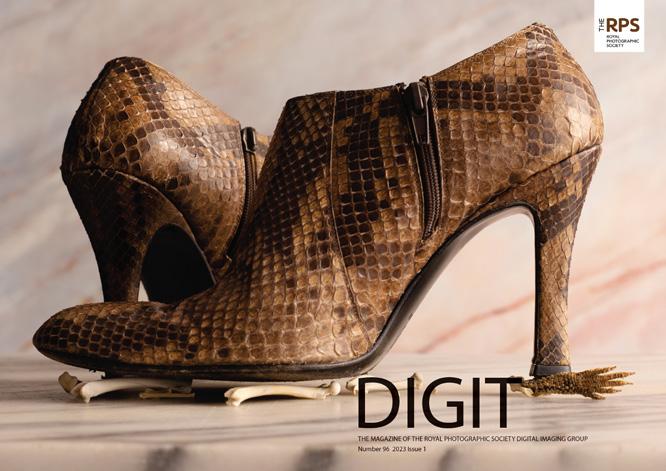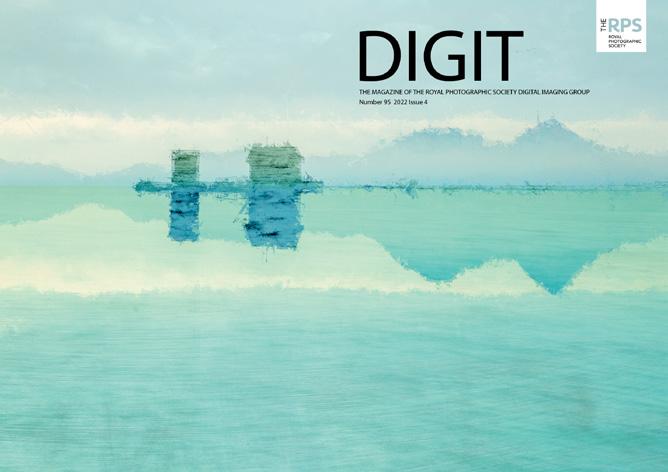




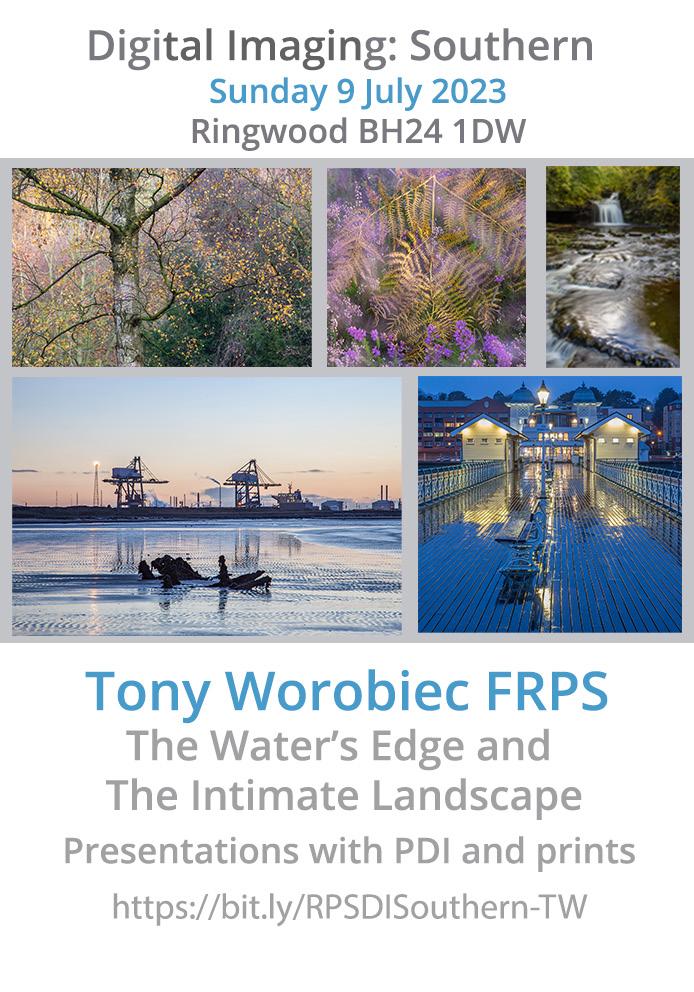
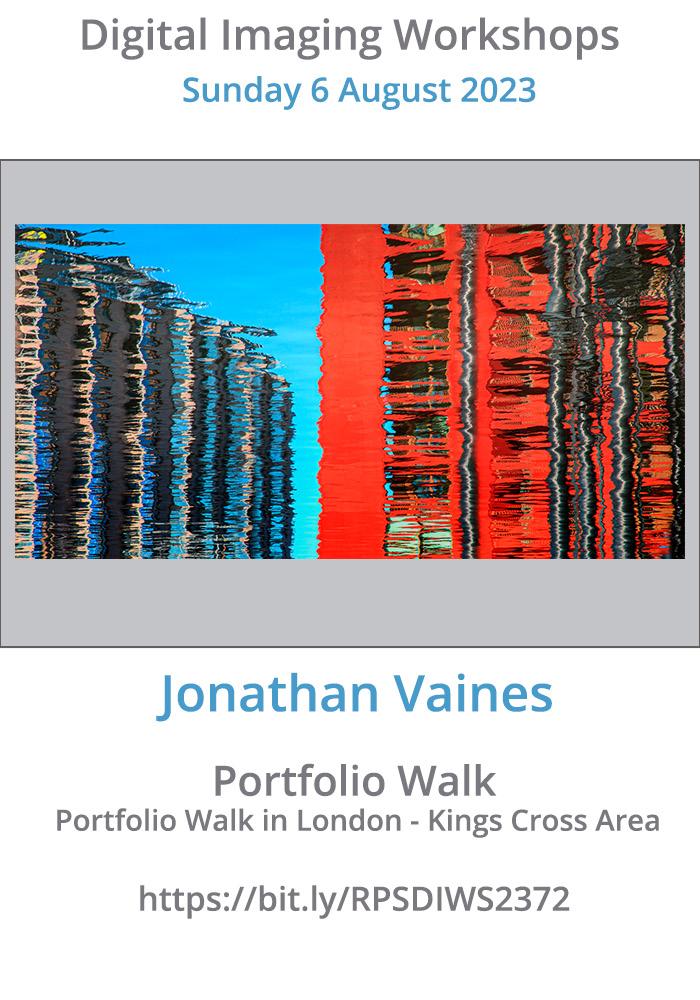



Details of all Digital Imaging events are available on its website at bit.ly/RPSDIEventsListingOnline

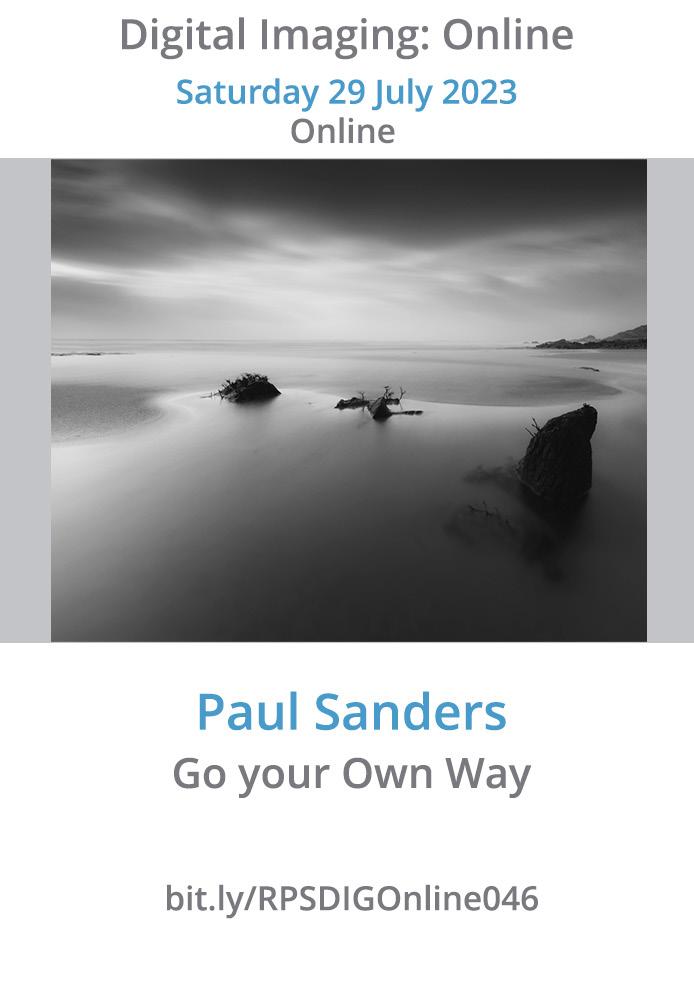

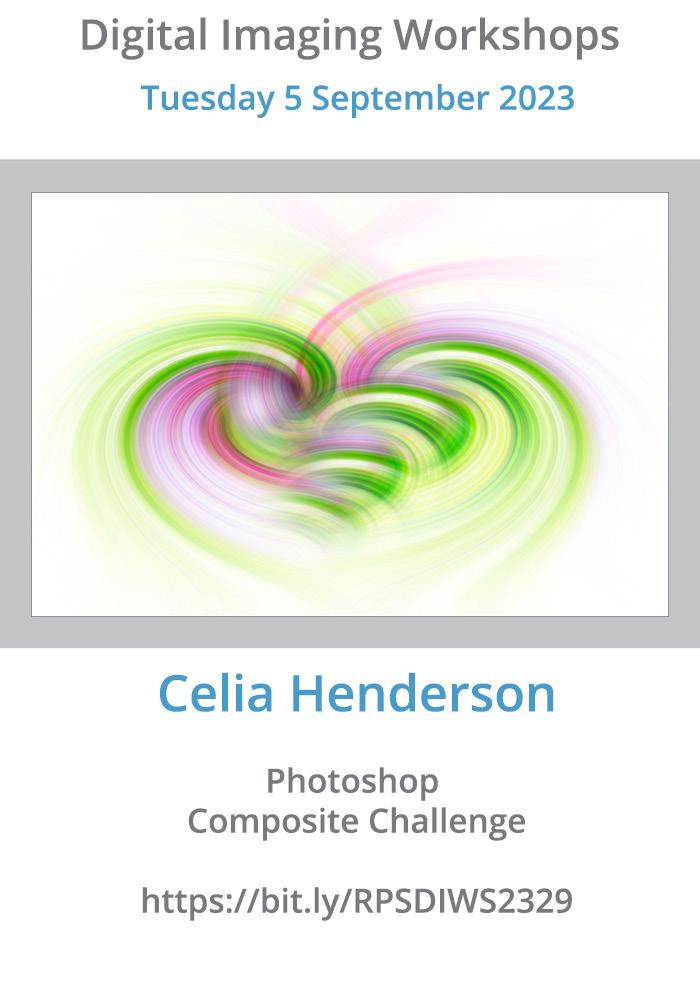

Janet Haines ARPS (Chair) digchair@rps.org
Trevor Pogson LRPS (Treasurer) digtreasurer@rps.org
Jocelyn Edwards LRPS (Secretary) digsecretary@rps.org
Melanie Chalk ARPS (Workshops and DI News) digworkshops@rps.org
Dennis Knowles (Accolade Editor) digaccolade@rps.org
Ken Ness ARPS (PI competition and social media) digweb2@rps.org
Jean Robson ARPS (Membership and eCircles) digmem@rps.org
Holly Stranks FRPS (Accolade) hollystranksphotography@gmail.com
Neill Taylor LRPS (Online Events) digevents@rps.org

Martin Tomes (Regional events) rpsdig@tomes.org.uk
Lois Wakeman LRPS (Web Editor) digweb@rps.org
Rex Waygood (Events) digexpo@rps.org
CO-OPTED
Gary Beaton (DIGIT Editor) digiteditor@rps.org
Sylvie Domergue (International) sylvielft@gmail.com
Deborah Loth (Casting Director) digcomms@rps.org
Booker T Skelding bookertskelds@gmail.com
DI CENTRE COORDINATORS
Southern Dr Barry Senior Hon FRPS 01425 471489 digsouthern@rps.org
2 Group events
3 Contacts
4 From the chair
Janet Haines
4 Editorial
Gary Beaton
5 Taking to bird photography like a duck to water
Maggie Bullock ARPS
13 You can tweak images in an app?
Nicki Gwynn-Jones FRPS
18 A Photographic Adventure in Rocky Creek Canyon
Brian Menzies and Albert Hakvoort
25 We each see the world differently
Alison Webber FRPS
29 Talk-Walk-Talk
Richard Ellis ARPS
31 DIGIT Challenge: Woodland Impressions
Jen Spiers
33 DIGIT
Cover image by Alison Webber FRPS
© 2023 Apart from storage and viewing in its entirety for personal reference, no part of this publication may be reproduced, stored in a retrieval system or transmitted in any form or by any means, electronic, mechanical, photocopying, recording or otherwise without the written permission of the Editor. The Royal Photographic Society, RPS Digital Imaging and the Editor accept no liability for misuse of any of the content or for any breach of copyright by a contributor. The views expressed in this magazine do not necessarily reflect the policies of the Royal Photographic Society or of RPS Digital Imaging.
Unless otherwise indicated, all images are from, and copyright of, the authors.


I have heard recently of one or two member resignations, where individuals have felt so disappointed by what the Society offers them that they have chosen to leave. Loosing even one member from our community saddens me, and I know that the Board of Trustees and our new CEO, Dan Jones, both understand the importance of each individual member and value their contribution. However, whilst the recent past has been disappointing in some ways for the Society, I feel that it is important that members know that things are changing for the better under our new CEO. It is fair to say that the distractions of poorly implemented technology have forced the Society’s senior management team’s attentions to be elsewhere recently, but to turn a large, unwieldy ship around takes time. We need to give our new CEO the opportunity to demonstrate to us his undoubted business skills, and in so doing I believe he will ultimately steer us back to being a Society that values and serves its members, and embraces the change needed to take the RPS forward to a sound future. By pulling together and being less divisive, group to group, staff to volunteers, engaging better with international members, we can all help to take the Society into a happier, more healthy future. And with that, provide more of what members want from their membership.
In part, DI are endeavouring to lead the way by actively trying to work with other groups and regions, by breaking down the silos in a small way. You will read on page 29 about our programme we are calling
As always, it has been a huge pleasure preparing this latest issue of DIGIT. The broad range of interests DI members have continues to amaze me, and in this issue we have another varied selection of topics shared with our readership.
Maggie Bullock found her speciality soon after coming to photography, and has since gone from strength to strength while capturing images of british birds (and particularly those in decline). Nicki GwynnJones was a perfectly happy photographer until fellow club-members opened her eyes to apps which could manipulate images, and she hasn’t looked back since! There are probably few photographs which
the Talk-Walk-Talk (T-W-T), which we will soon be launching with the Landscape group. Providing the inaugural event is a success, we have plans to move forward to other topics for future T-W-T projects. In addition to working with the Landscape group, the T-W-T joint team has reached out to the Regions inviting them to engage with the programme too. One or two already have, and it is hoped that as others see the success of the programme, and recognise that their members may value such opportunities, that they too might join in future rounds.
Through the Society’s Members Committee, to which a representative of each Special Interest Group and Region is invited, we also share best practise and ideas. Through this committee, we find some volunteers have become experts in running exhibitions, for example. It is well worth looking at the Landscape web site and their travelling exhibition. It will be in Bristol at Clifton Suspension Bridge during June. If you are in the are, do take the chance to get along to see it, or look out for it in your local area.
In receiving this DIGIT magazine, we know you are a DI member; but firstly you are a Society member. DI values your continued support and we hope that you feel you get good value for money from your annual subscription with us - if not, or worse, if you are considering giving up your membership of DI or the Society, let us know what we can do better. Engage with as much as you can as then you will feel part of the community and valued. But sometimes it is well worth looking over the fence to see what our neighbours are doing too - they may well surprise you.
start with a trip to the gym, but on a quest to capture a particular photograph for himself, Australian member Brian Menzies and his friends set out on an adventure which started just that way. Alison Webber explains how she sees the world differently to many other people, and how this affects her photography. Richard Ellis from the Landscape Group, tells us about a joint project being offered with DI, to bring members together and enjoy a nice walk. Finally, we have two DIGIT Challenges from Jen Spiers and Ken Hurst-Earl telling us how they created their images. As I mentioned, a varied selection, which I hope you will enjoy as much as I have.
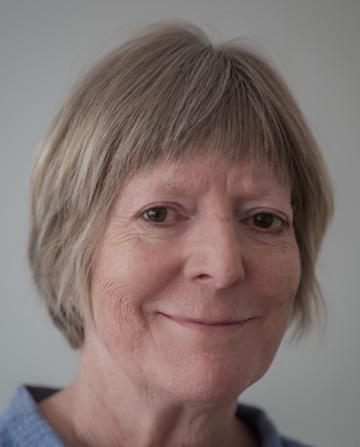
Quite early on in my photographic journey I became hooked on photographing wildlife, in particular birds, and gained my ARPS in 2018 with a panel of ‘Birds of Conservation Concern’ (BOCC). Prior to this I enjoyed taking images in a few different genres but eventually decided to solely concentrate on wildlife, in particular bird photography, to try and improve my skills and the overall quality and impact of my images.
I enjoy walking in the countryside or in a nature reserve, watching birds
and observing them in their natural environment, and learning about identification and behaviour. I find the whole process of watching and photographing both peaceful and relaxing, almost meditative, and I like the challenge of trying to get good shots that emphasise the beauty of these creatures.
I also have great concern about the general state of nature within the UK, an example being the decline in bird populations, with now seventy bird species categorised as red listed, including the Common

Sparrow!
For anyone embarking on bird photography there are several factors which can help with achieving your goals:
If your aim is to take images of birds in their natural environment it’s necessary to locate your subject matter. I recommend exploring local nature reserves and other walks, such as coastal, river or canal paths to understand what bird species can be found in different
seasons. It’s then possible to build up knowledge of what you might see and when, and to go out with this in mind. For example, there could be an influx of Short-eared owls over winter in a coastal area, or various Warblers will start to inhabit reedbeds in late April. Keep an eye on social media, which is always a good source of sightings. I also like to visit other locations in the UK that are renowned for their diversity of bird species, such as North Norfolk and RSPB Bempton Cliffs. Another useful item for locating birds is a pair of binoculars, and you will soon develop a thirst for learning about
the species, habitat and behaviour of your subjects.
In a hide it’s often tempting to take a quick look, and if there’s nothing much there, move on. Wildlife is erratic and anything can happen so sometimes sit it out and be patient, you never know what might turn up!
If you have favourite species, concentrate on these as you’ll be more inclined to go out and less likely to lose enthusiasm as time goes by.
Once you have located a bird that
you want to photograph, whilst walking around, it’s vital that you don’t scare it off! It’s best to wear muted clothing, and if you want to get closer, move very slowly and try to keep low. The best approach is to take a couple of shots, try to get a bit closer then take a couple more shots. If you are in a habitat that you know is frequented by birds, such as Gorse on a dune habitat, just sitting and waiting for them to turn up can be quite fruitful.
Photographing from a hide obviously lets you get closer to your subjects. Pop-up hides can be

used but you would need to get permission from the landowner for this, unless it’s in your own back garden! It is sometimes possible to use your car as a hide if you can safely park.
The image of a Starling on a rock (see page 5) was taken from my car, parked in a layby.
Natural lighting can add considerably to an image, very similar to the principles of landscape photography. The golden or blue hours, or winter
light, can really add an extra element to the image. This involves going out early, much easier in the winter, or just when the sun is about to go down. The image of a Yellowhammer on a Gorse bush (see previous page) was taken on a morning in mid-March, with the sun still quite low in the sky which provided a bit of a gentle glow to the image.
Whilst shooting, get down low if possible, as this can give a more intimate perspective. A similar result can be obtained if you
shoot whilst the bird stands up on the edge of something, such as a ridge or a fence, resulting in a diffuse background, which allows the subject to stand out from the background. The image of a Female Stonechat perched on band of seaweed (below) shows how a low perspective, coupled with a reasonably shallow depth of field (f/5.6) achieves that diffuse background. The image of a Mistle Thrush perched on a fence (see page 12) also has a diffuse background.
If the bird is on grass or amongst
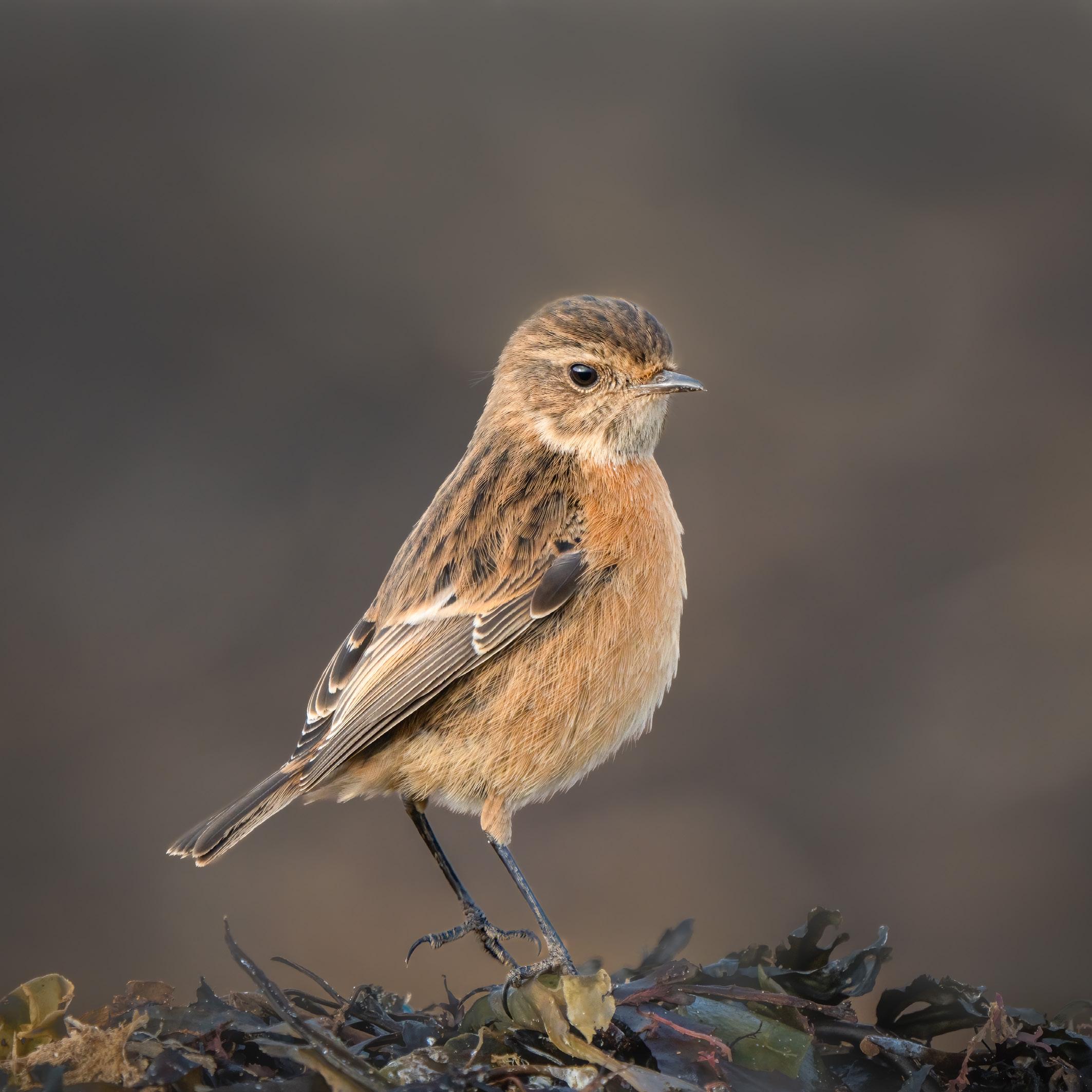
branches and a diffuse background isn’t possible, move around to try and reduce clutter or branches that create highlights in the background. Trying to improve backgrounds in camera is easier than dealing with highlights in post processing.
It’s also useful to include elements of the environment within your frame, so if you have a telephoto lens don’t zoom in too closely on your subject as you can optimise the crop in post-processing. The Great White Egret (above), with back lighting shining through the feathers, also shows elements of its environment.
Get to know more about your subjects and their behaviour. This could help you whilst shooting, for example, a bird that is bathing will more than likely flap its wings when it’s finished, which adds interest to the final image.
Very importantly, whilst taking wildlife photographs, there is one hard and fast rule, whose spirit must be observed at all times: the welfare of the subject is more important than the photograph. Check out the Nature Photographers’ Code of Practice, produced by the Nature Group of the RPS, in consultation with the RSPB and the three
Statutory Nature Conservation Councils. You can find it at rps. org/media/1xcnsuga/the-naturephotographers-code-of-practice. pdf.
Whatever camera you have, it’s usually necessary to have a lens with a focal length around 500mm or more. It’s important to get to know your camera as much as possible, though the menu systems and options can often seem daunting. There are many articles available on
the Internet and YouTube that can assist with optimising your camera for bird photography.


My camera system has a feature that buffers images in memory, and when the shutter button is pressed all the way down will write a pre-defined number of images to the card. Though very helpful, this feature requires a lot of practice as often the bird takes off in the wrong direction, and many tries are required to get acceptable images. The image of a Male Stonechat taking flight (below) has been captured using this feature.
For focusing I use back button focus (BBF). You focus with the back button (as an example, labelled AFON), using continuous autofocus mode then press the shutter button fully down to take a shot. This works primarily for tracking movement and flight but also for more stationary subjects, which saves you having to change settings so frequently. I also use auto ISO but set an upper limit for this of 6400, which means that I only need to set the focal length (for a telephoto lens), aperture and shutter speed for a particular sequence of shots.
I always shoot in manual exposure mode. Applying plus or minus
exposure compensation achieves the required exposure. In general, my aperture is wide open at f/4-5.6, depending on the focal length of my telephoto lens. If I have multiple subjects and I want them both in focus, I increase the depth of field by setting a higher aperture number, such as f/8 or more, depending on the camera/lens model.
The standard rule of thumb for a full, frame 35mm sensor is to make the shutter speed a minimum of your focal length when handholding your camera, to achieve an
acceptably sharp image. If you are shooting with a 400mm lens, set the shutter speed to 1/400 to avoid blur from camera shake. Further guidance for non-full-frame sensor cameras is to consider the crop factor. For example with micro four thirds use double the shutter speed compared to the focal length of your lens.
To freeze the wings of birds in flight you typically need a shutter speed of 1/1600 for a slower bird such as a heron and up to 1/4000 plus for smaller birds. If I am taking more stationary subjects and my
ISO setting increases due to low light, I reduce the shutter speed to decrease the ISO, which should improve the quality of the image. Experimenting with slower shutter speeds and flocks of birds in flight can give some interesting results!
In general it’s important to get images properly in focus and sharp. I recommend practising first with stationary birds (maybe on sticks!). Many nature reserves have a hide that provides good views of bird feeders. These are useful places to
u
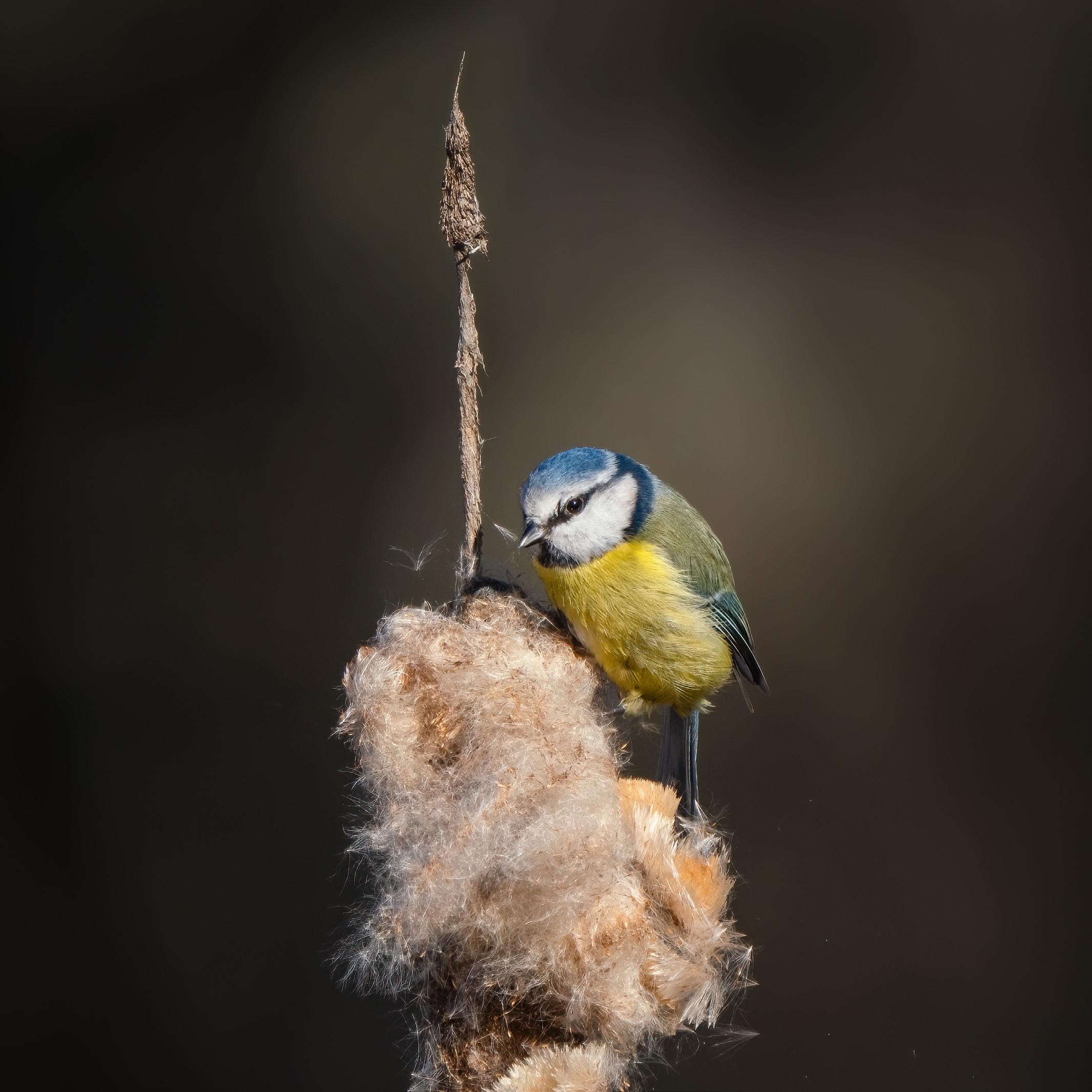

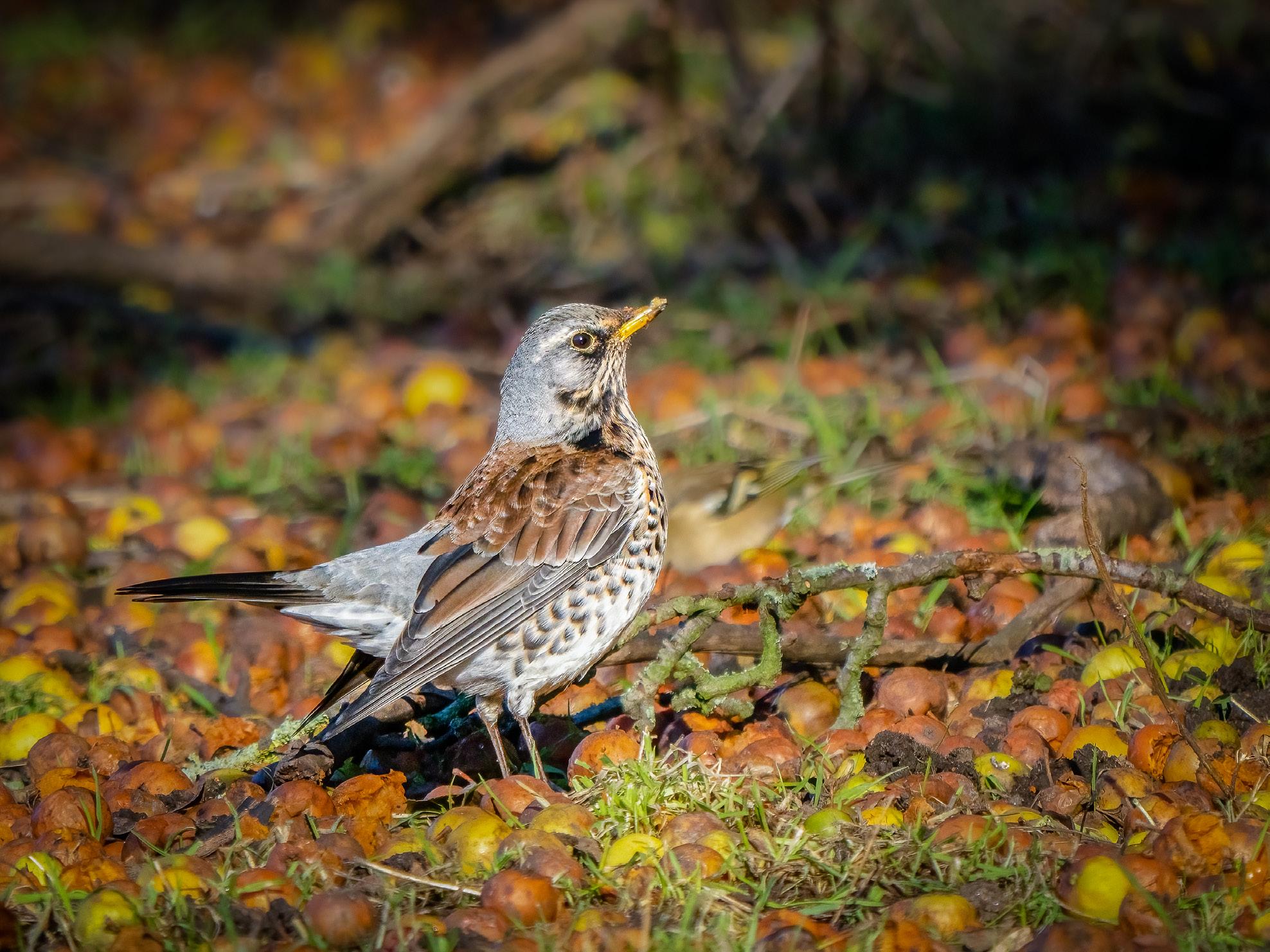
practise getting sharp images of birds. Often the birds will alight on a branch for only a few seconds, so it’s good practice to try and get sharp shots in these situations. Many cameras now have subject detection for birds, which is a very useful feature. This image of a Blue Tit on a bulrush (see page 9) was an unexpected sighting and provided a good exercise in achieving a sharp subject.
Once you have mastered the more stationary subjects, move on to birds in flight. If you are near to a lake or the coast, gulls make very good subjects for practising this technique.
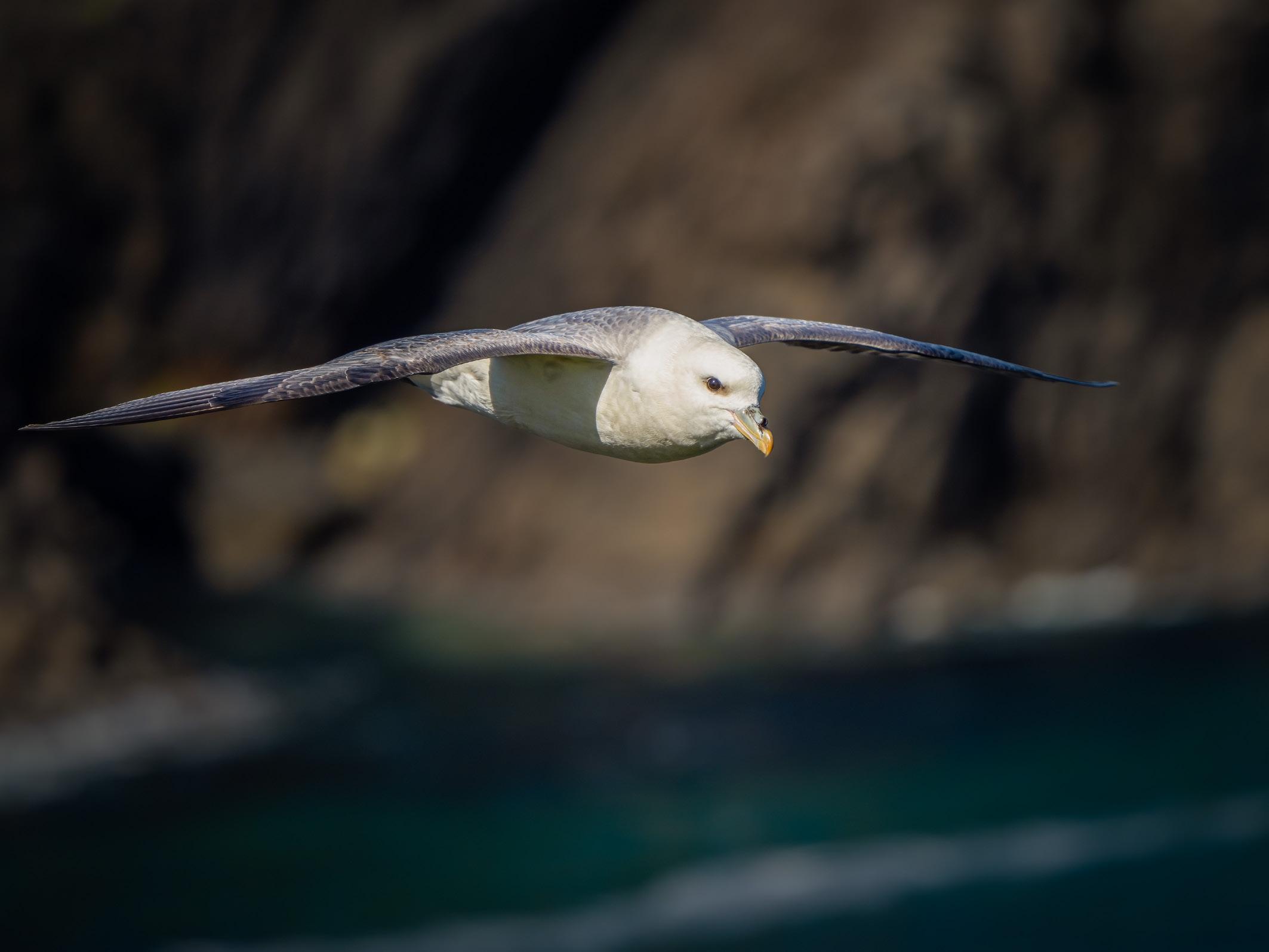
After a particular visit you could be pleased or disappointed with your images for various reasons. Often, it’s useful to go through your images soon after shooting to understand how you could improve,
especially if trying a new technique. Sometimes I think I wish I’d taken a similar shot but better in a particular way and then I want to go back to have another go. There may be only a small window to do this as otherwise the bird may have flown! Whilst on the Isle of Lewis I’d been told that if you walk to the top of the headland, Fulmars (below) will fly past, almost as if they have come to take a look and see if you’re a possible threat. I went to the spot a few times to try and get a sharp shot of one coming round the headland.
Another viewpoint is that you wait awhile before reviewing/processing your images, as you distance yourself from your shooting experience and can be more objective about your images.
I use Lightroom (LR) for most of my processing. The LR catalogue
means it’s easy to find images; I name individual folders with their location and date. The collections are extremely useful; I use them to collect images for competitions and Distinctions. It’s so easy to create a panel of images and move the images around until they look pleasing together.
I load my images into LR, applying my own basic preset during the load process. Reviewing the images, I either go through deleting the ones that are out of focus or just not very good. Sometimes I carry out an opposite process of picking images I want to keep. When I have gone through them all I select all the ones picked, invert the selection and delete these. The downside with the latter approach is that you can only delete images once you have been through them all. After reviewing I will pick certain images to process further. Typically I send an image to Topaz Denoise
plugin but make sure I remove the default sharpening applied by LR before this, as this reduces the possibility of creating haloes within the image. Once the image is saved back to LR I carry out further processing using subject selection. It can sometimes be overwhelming, due to the number of images that can be taken in any single session (1000+ in a day!). However, for any sequence of images it’s always possible to find one or two that are more pleasing and capture the bird’s character more fully; maybe the bird has turned its head slightly and there appears to be a connection, or the catchlight is stronger. To restrict how many shots are taken may cut down on the proportion of these better images.
I enjoy entering competitions as I find this a useful barometer as to how my wildlife photography is
developing.
My current long-standing project is to continue taking images of Birds of Conservation Concern, which are UK birds in decline and on the red list, such as the Mistle Thrush (above).
I hope this summary of my approach to bird photography has been useful, and perhaps will encourage some readers to try out this very enjoyable and fulfilling type of photography
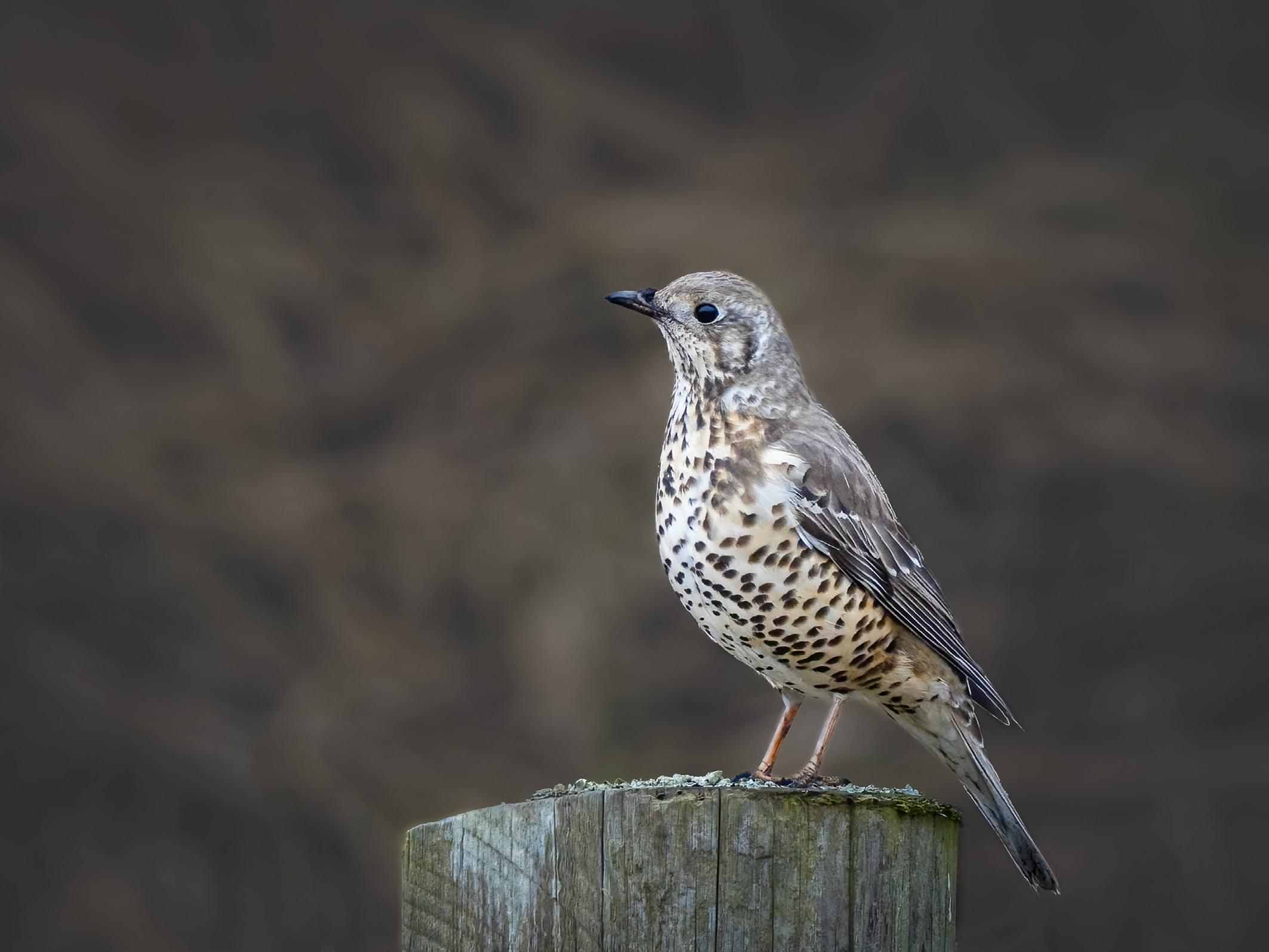
NICKI GWYNN-JONES FRPS
Returning from a stint in the USA in 2007, and as a fledgling photographer, I joined a camera club to learn and to meet likeminded folk and was amazed and
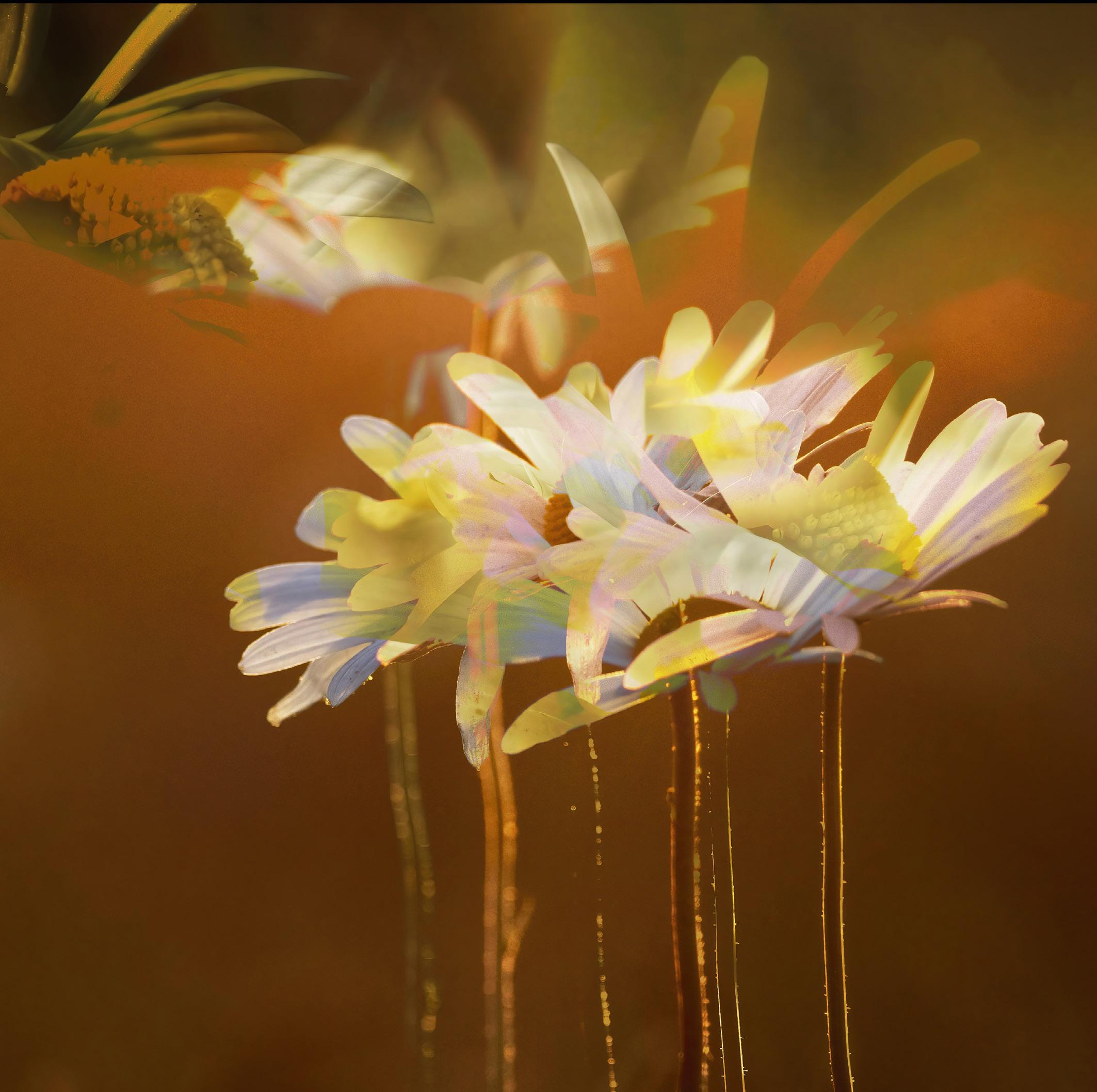

slightly disconcerted to discover that it was quite alright to tweak one’s images in something called Photoshop, and that some people constructed whole images from
only their imagination. I had spent the previous twenty-five years or so working and raising a family, so hadn’t got out much - and it showed!
Nature has always been what I love to photograph - birds in particular - influenced by my parents and my beloved Auntie Catherine. She was an extremely talented woman, an oboist, an artist, and with a deep knowledge and love of wildlife. Mental health issues prevented her from sharing her gifts, but after she died, I could feel her on my shoulder imploring me to show the world what she could not.
A few months later, an error whilst photographing a snowy egret in high-key light changed everything. I had mistakenly dialed in the wrong camera settings for the images that I thought I wanted and ended up with an ethereal and somewhat abstract vision of the bird tussling with an eel. The slight motion blur and complete lack of any kind
of distraction made the image look like a watercolour painting - washed-out, pure essence, the spirit of Heron right there on the screen in front of me. I understood then that my photography would be all about trying to capture this essence and to allow my emotional responses to inform my image making - I would need to work creatively and intuitively.
In 2016 we moved to Orkney, a land alive with the echoes of mythical creatures and ancient stories, carved from wind and relentless waves, and whose vast skies cast light and shadow in endless shapeshifting beauty. I quickly fall under its spell. Winter here can seem interminable, but in spring the lapwings bewitch me with their wild lamenting spirit and tumbling
courtship dance, and the bubbling call of curlews haunts the sodden fields, an up-welling of sadness for eternity. The simmer dim, the perpetual twilight of midsummer in the Northern Isles is like a dreamtime, that place between sleeping and waking, where lines are blurred but all things become clear.
At first, I do not know how to convey any of this; I wander around with my head in the clouds - literally at times - trying to figure out a way to get in touch with the magic that hums all around.
It begins with the flowers; it dawns on me that to find this magic I will need to be creative and work on an intimate scale - I have never been good at the grand landscape shotsand that in the wild places amongst the cotton grass and buttercups, in the spaces where mystery and imagination collide, here is where I would find it.
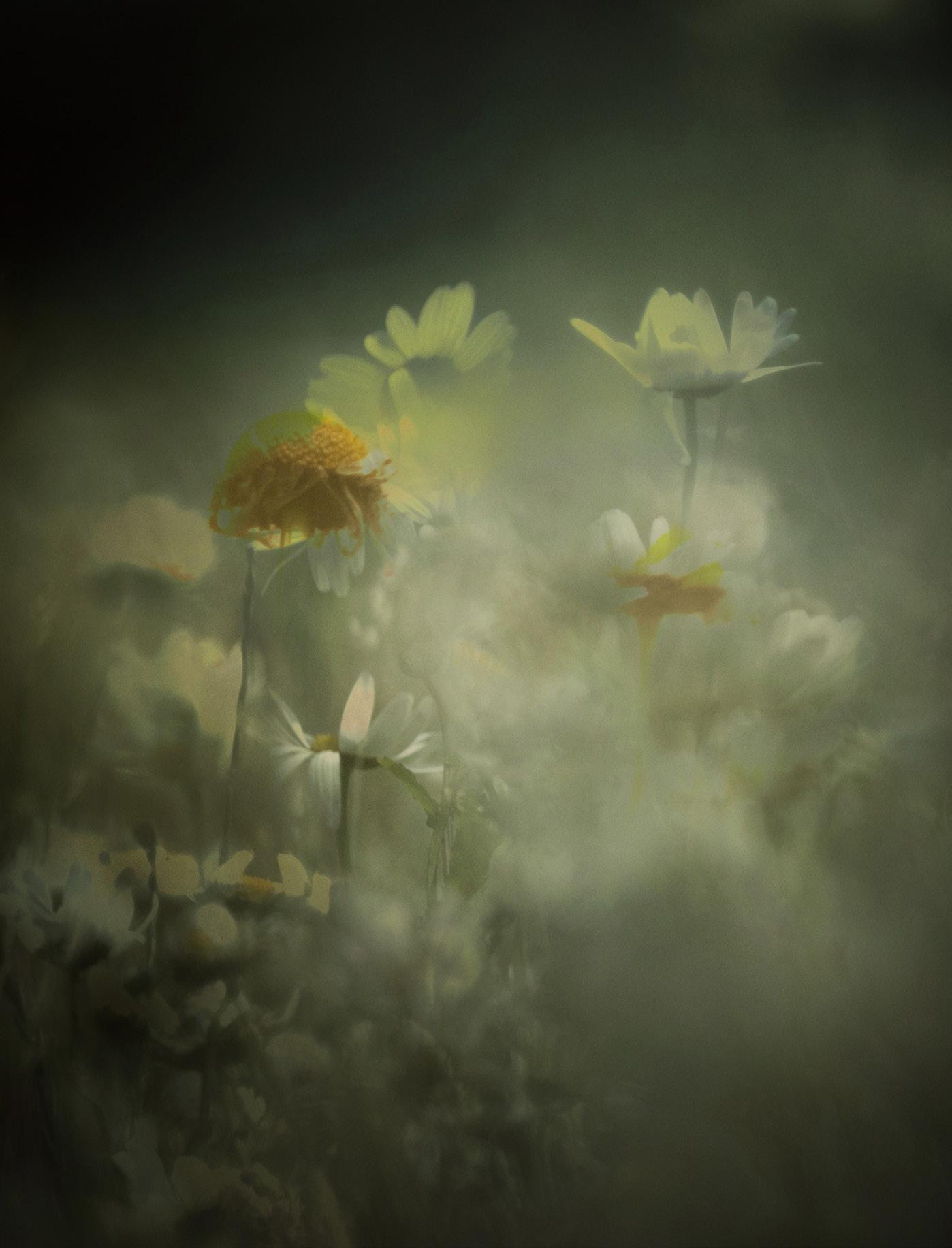
Lying nose to the wet ground, I focus manually, millimetre by millimetre, until I have a sense of something fleeting, not quite seen and impossible to hold on to. I know when I have found what I am looking for - I cannot tell you how I know…
I have been told many times that my images are very recognizable, which I guess is fine, but there came a point a couple of summers ago when I felt that I needed to incorporate a slightly different approach, and to expand the range of options for self-expression and for making creative imagery. This was when I discovered the Snapseed app, and it has proved to be a game-changer for me. I found that I like working on my phone - it gives me the chance to be creative anywhere, anytime, which I really enjoy. Within the photographic realm, visual art has always felt like my natural home, and I have no interest in technology, so no-one was more surprised than me to find that I love experimenting with an app. I never would have imagined that it could provide a playful
extension to my musings and imaginings, but so it has proved to be, and once again, it began with the flowers…
In summer, oxeye daisies grow here in abundance, and there is a meadow very close to our house that offers some wonderful opportunities for creativity. It is perfectly positioned for sunset shots, and I am eager to find out what the multiple exposure element of the app will yield. I have little interest in the process by which I arrive at a result - once again I know when I have found what I want, which is something of a relief, as my biggest fear was not knowing when to stop with the playing around.
I call the series Gaudy Nights. The images take me to the bliss of an all too rare warm, still Orcadian summer evening, oystercatchers fussing on the tidal flats nearby, an occasional bee taking advantage of the balmy weather, and a handful of defiant midges in waiting, as the setting sun dips below the fields, irradiating the flowers in a blaze of glory.
A high key day yields a different kind of image, muted, more typical of soft, beautiful Orcadian light. Close by, a neighbour has planted some ornamental poppies, stunning whilst in bloom, yet I fail to create anything passable. But the seed pods…bursting with the promise of good times ahead! I have some fun with the multiple exposure and vintage tools, keen to enhance the strong shapes and to create an abstract interpretation. We do not get much snow up here on the 59th parallel as we are warmed by the Gulf Stream, but one morning in December I awake to a white-out world, the drystone walls carving sinuous shapes into the silent fields. Just after 9am, as the sun drags itself reluctantly over the Deerness peninsular, the scene begins to sparkle, and I know that I do not have much time. I grab my long lens and drive, gingerly, a mile or so down the road to a small quarry where I hope that I will find a
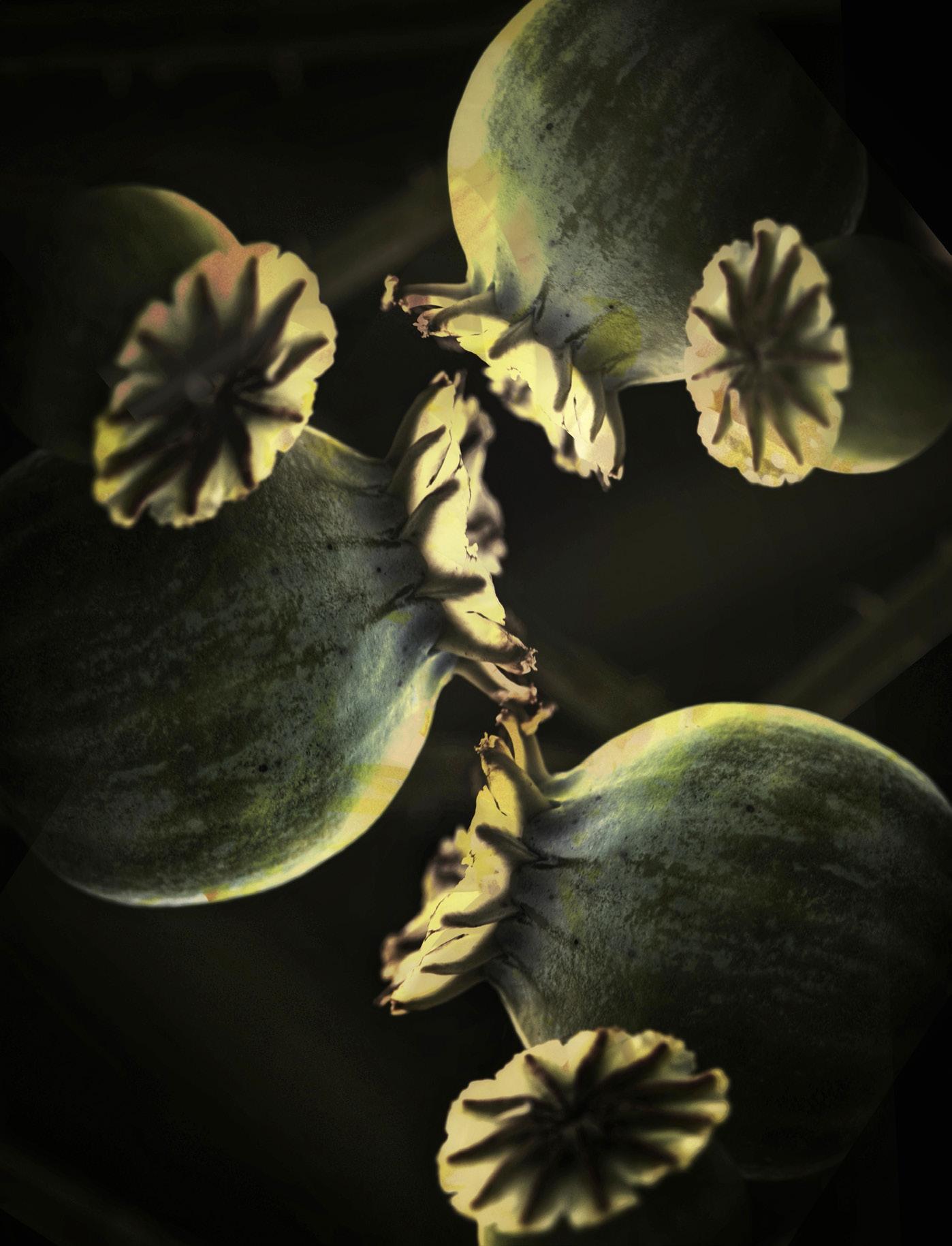
selection of snow-covered grasses. I lie face down on the wet snow, focusing on the melting droplets lit by the sun as it begins to trace its low arc across the winter sky, just 10 degrees above the horizon. It is as if the scene has been decorated by fairies, and for a few seconds I am allowed a fleeting glimpse into their realm, evanescent and captivating. I hardly dare breathe, but then, just as quickly, the show is over - the fairies have granted me their gift and turned out the lights.
I hurry home, eager to discover whether I have captured the magic, but of course I am disappointed - the images are too literal and certainly would not pass muster with the fairies. I decide to try the multiple exposure tool in Snapseed and find that I can create something
much more ephemeral - just as well, as the fairies ensure that you are left with little memory of their world, but rather, that sensation you have after a dream that you try to recall, vanishing into thin air as you try to grasp it.
A few weeks later we have a bitterly cold snap. I head to a beach, hoping for over-wintering longtailed ducks, but they have taken refuge elsewhere. A biting north wind is bringing spectacular snow clouds - Orkney’s wide-open skies are the perfect ringside seat - and I decide to try my hand at some wide-angle shots. I admit to being a little afraid of anything other than a telephoto lens…
A conversion to black and white seems to suit the mood and I even go as far as playing with the noir


tool.
A holiday in Northumberland is never complete without a visit to the remarkable rocks of Spittal Beach. This time I find that they are fairly well covered over, and I decide to try a different approach, as I have many straight shots of their gorgeous colours and curves. The weather is typically British - grey skies and white-horse waves cresting in the bay, fearless blo-karters careening along the beach, sand swirling, enormous sails billowing, flamboyant, going like the wind, and the Sandwich Terns calling, mob happy after their long migration from the Southern Hemisphere, diving in spectacular
Tom Daley fashion into the frigid North Sea - and I think that I will try to capture the feeling of this lively scene, something that will echo the movement that is all around me, along with the drama of the friable cliffs that loom over the southern end of the beach.

This time I am working on my mobile, as I find that I can ‘see’ the images more easily. Later, once out of the relentless southeast wind, I play with Snapseed’s multiple exposure tool, experimenting as I go, and I am happy with the final results.
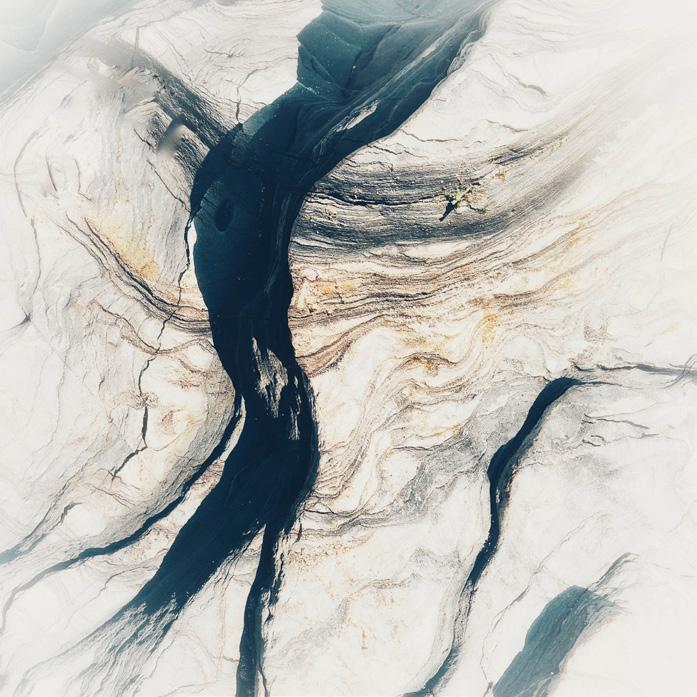

I read somewhere recently that playing around with apps and filters is a lazy way to be a photographer. I
disagree. I have discovered all kinds of exciting possibilities and ways to present my work that previously I never would have considered. It is a lot of fun; it has encouraged me to be bolder with my creativity and I am going to be expressing myself in this way for a long time to come. I invite you to try it!

The background
Brian: Albert and I have been photography buddies for a number of years. He and his wife Eliane, have been avid abseilers and canyoning aficionados for the last 25 years, and during the last five years, have become serious about photographing their canyon adventures.

Before the pandemic, Albert captured a stunning photo of sunbeams in a canyon, and on showing me, my instant comment was, “I’ve got to shoot that”. That was the beginning of a long journey.
A key requirement for canyoning
is a high fitness level and good strength. I’m 73 and was in reasonable shape but I had to intensify my gym workouts to prepare.

With the arrival of the pandemic, we were locked down and unable to travel into the Blue Mountains west of Sydney, the location for the canyon. As pandemic restrictions started to ease, we were allowed to venture further afield, but it was winter and canyoning is a summer adventure, so our attention focused on the charms of winter photography, especially sunrise and the Milky Way. A favourite location is the Bombo Quarry, south of Sydney.
The area is full of boulders and loose rocks, and I had the misfortune of stepping on a loose one and crashing my knee straight into a boulder. I managed to hobble out of the quarry but could not walk the next day. Albert organised an ice pack, and I stayed put with my knee raised, regularly changing the ice. I had found a broom that when turned upside down, improvised as a crutch. On returning to Sydney, a scan revealed I had fractured the top of my tibia plateau and torn the meniscus. The good news was that I didn’t damage my camera or lens in the fall. Phew, big mercies. What followed was resting up and implementing a
healing physiotherapy routine. I was banned from putting a load on the knee for 12 weeks. So much for all my gym preparation for the canyon; I was back to minus square one. With the approval of my physiotherapist, I started back into light upper body gym work until the knee healed, and then I was full bore back into gym training again. By the time summer arrived, it was three years since I had seen Albert’s photo, and now, I was ready to go.
Albert: Once the pandemic restrictions were finished, the three of us were available to do the shoot on many occasions, but the critical factors, we couldn’t personally deliver were the precise weather and rainfall conditions to all come together on a given time and day. These were:
• No large rainfall in the previous five days as flooding can occur in the canyon.
• The access road must be open for public access.
• The day must be sunny and largely cloud-free. I use a number of weather forecasting apps and rely on the mean average to use as the forecast.
• High humidity - the humidity must be higher than 70%; the higher, the better. The Weatherzone app lists humidity up to seven days in advance.
• Low wind - wind in the canyon can blow the humidity around, disturbing the sunbeams and it can also drop the humidity in the canyon by bringing dryer air from outside the canyon. No

humidity, no sunbeams. Again, I use Weatherzone for this. To capture sunbeams shining in the canyon, you need humidity to illuminate them.
Eliane and I have spent years exploring the Blue Mountains and are very familiar with the canyons in the area and have a thorough knowledge of what is required for safety, equipment and expertise. We were able to kit up Brian with the specialist equipment he needed. This included:
• 60 ltr. backpack with drain holes
• Steamer wetsuit
• Wetsuit socks
• Canyoning boots
• Helmet
• Dry bags
• Flotation wine bladders
On top of this, I carried, in case of an emergency;
• Personal Locator Beacon
• First aid kit
• 15 metre abseil rope
• Harness
• Carabiners and an ATC (a descending device)
The last factor was that we all needed to be available. It was important to have Eliane with us as her experience was valuable in assisting and being my safety backup. On 29 January 2023, the forecast for 1 February 2023 appeared to have all the above ingredients, so the decision was made to give it a crack.
Arriving at the shoot location is time critical as the height and angle of the sun mean it will be penetrating through the splits in the canyon ceiling. Ideally, we had to arrive at the shoot location in the canyon at 8.30 am when the sun would be shining through and should last until between 10.00 and 11.00 am. Working backwards from the planned shoot time, I calculated the target times we needed to meet.
• Aim to be at the shoot location at 8.30 am
• 45 minutes to get up and away from our overnight accommodation. Alarm time 5.00 am
• 1 hour to drive to the Rocky Creek car park. Departure time 5.45am.
• One-hour trek from the car park to the canyon opening also allowing for changing from our bushwalking gear into our canyoning gear. Trek in start time 6.45 am.
• 45 minutes navigating the canyon to the shoot location. This is towards the end of the canyon.
• Enter the canyon at 7.45 am
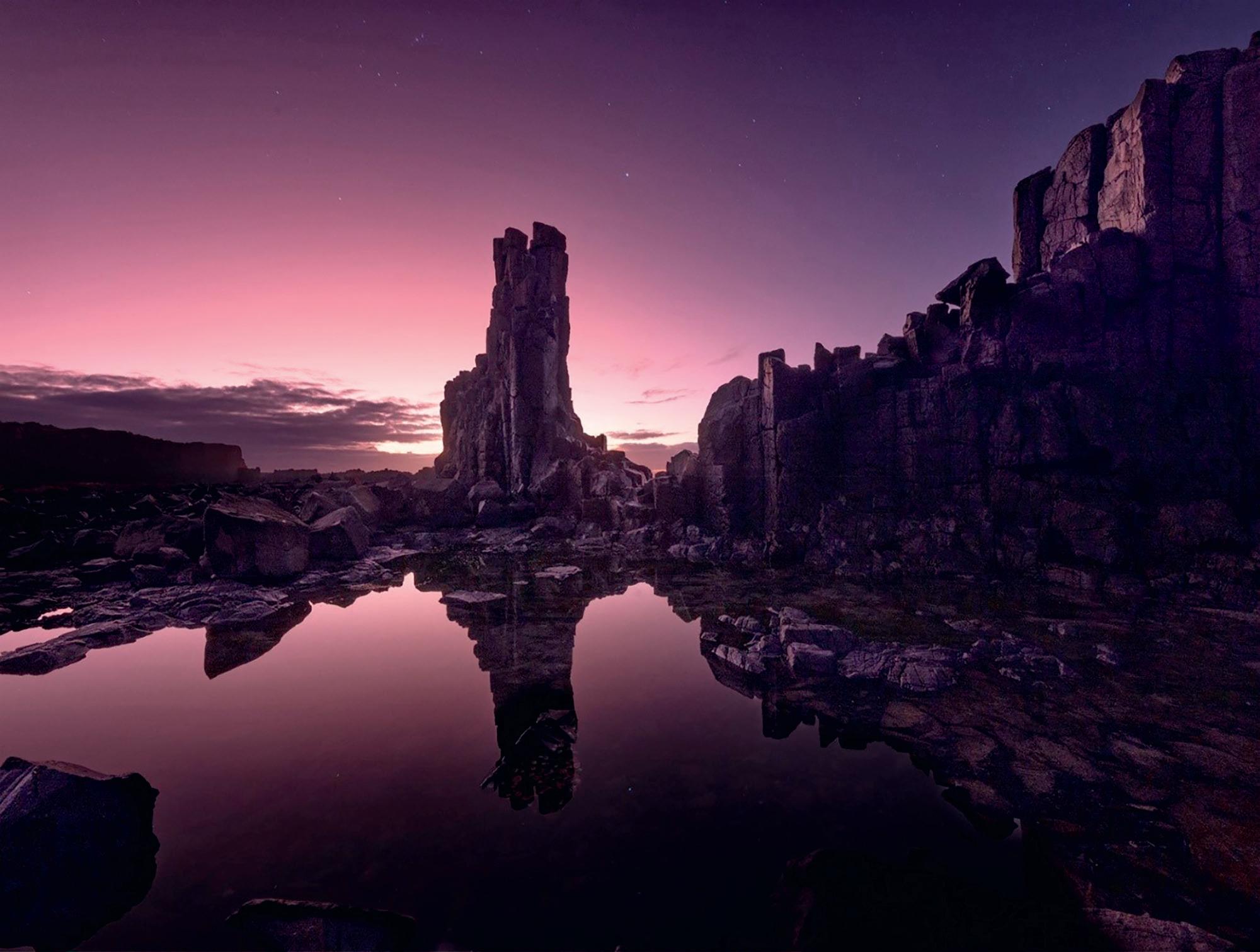
Brian: Once you leave the main road, the drive to the Rocky Creek canyon carpark winds and twists its way via a dirt road through farmed and native forests. We all had our eyes peeled to spot the kangaroos close to the road as they jump
and run in any direction as the car approached. Hit one of those, and your photography day may come to an unplanned end. We lost count of the number we saw; it was an incredible breeding season with lots of feed available. Fortunately, they bounded away into the trees, and we arrived safely at the car park.

It was time to start the trek in. All of our equipment and supplies, food, tripods, cameras, lens, and canyon clothing, were already packed in our backpacks, and we were on our way, walking sticks in hand. The bushwalk down to the start of the canyon track was along a welldefined path. It’s a very popular canyon, so it gets a lot of traffic. Within ten minutes, we encountered a very steep eroded section, so we were glad to have our walking sticks.
A tree had recently fallen over the track, and we had to find a new way under and around it to continue. The following creek section is strikingly beautiful, with the track
carpeted in fallen leaves and many large tree ferns sitting above crystalclear pristine pools.
The single-sloping track continued downwards. This was covered and completely hidden by bracken fern. I had absolute trust in Eliane and Albert’s navigation, and they also had me walking between them for safety. We couldn’t see the defined track and were climbing over fallen logs and making our way down over large rocks.
In my inexperience, the next challenge was a touch daunting. We arrived at the top of a five-metre cliff with an old Coachwood tree growing on the edge.
Albert: I removed my pack and using a permanently fixed hand line, as well as tree roots, then worked my way down. After lowering all the packs down the cliff to me to make the descent easier, Brian followed my example, with me telling him each move to make with his hands and feet. Next came Eliane with her
normal confidence. At the base of the cliff, the valley started to close in, and two minutes later, we came to a two-metre drop-off.
There was a large tree root growing diagonally, and I again removed my pack and used the tree root to climb down. After passing me the backpacks, they came down using the same diagonal tree root.
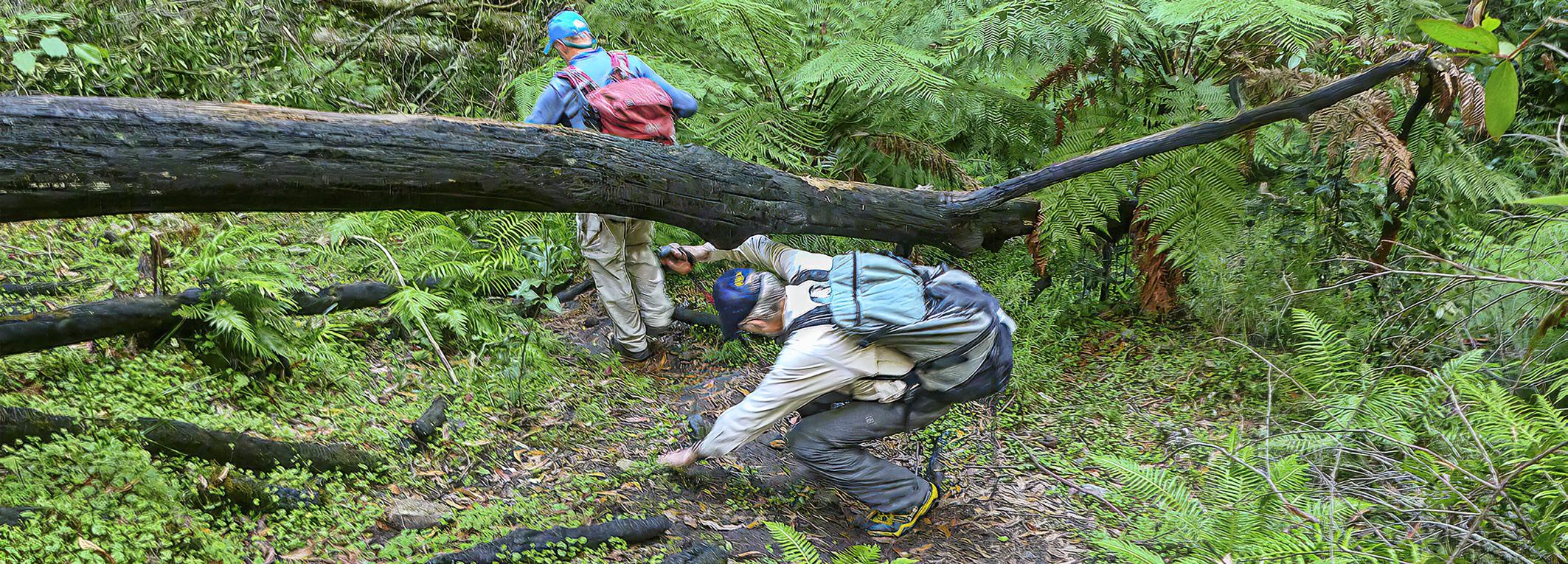
The next 20 minutes were spent following a creek system that feeds into the canyon. In this section, to lessen our gear in the canyon, we hid water bottles and our walking sticks which we required only for the walkout.
Brian: As we got closer to the start of the canyon, I could hear the thunder of a waterfall, and after jumping the creek that feeds the waterfall, we arrived at a rock slab at the top of the waterfall. The canyon’s opening greets you with a five-metre cliff and a waterfall plunging into a pool. We changed into our wetsuits, and Albert
instructed me on waterproofing all photographic gear and trekking clothes in a sealed dry bag which in turn was placed inside another sealed dry bag, and then into the packs. We were about to swim in deep water to navigate parts of the canyon. A small hand towel was also stowed in the top of the outer dry bag. The doubling up of the dry bags keeps all the gear dry. My pack was around 8 kgs, Eliane’s was around 9 kgs, and Albert’s was around 15 kgs. They were both helping me out by carrying some of my equipment.
Albert: Canyoning involves working your way down a creek system that has eroded the rock over millions of years into canyons with slippery rocks, deep pools to swim through, fast-flowing water, and waterfalls. Abseiling experience is sometimes required to negotiate deeper into the canyon’s depths. Negotiating canyons can be strenuous,


dangerous and hyperthermic so you have to be prepared.
Brian: Once we got changed and started to make our way down the canyon, the first obstacle we had to negotiate was getting to the waterfall’s base. You could either jump into the pool below, but that wasn’t recommended as this is the first time for me. The only other way down is to go through an eroded rock hole with our packs on. This interesting circular hole has been etched out by water flow over millions of years. There is a fixed hand line to use for safety in getting to the hole opening. You’re on the edge of a five-metre high cliff, after all. Once you pop out the bottom of the hole, you arrive at the edge of the waterfall pool.
We now make our way carefully into the canyon, walking deliberately and checking that our feet have traction on the slippery rocks. Our first swim came up quickly, and I
soon learnt why a wetsuit is needed. It was cold water, but man, it was fun. I floated on my pack (kept on the surface by the inflated plastic wine bladders) and propelled myself with my arms. Out of the pool, our next challenge appeared. To progress, we had to find our way
down a two-metre-high drop to a plunge pool with a waterfall coming in on the side.

Albert went first to check it out and guided us through it safely. He was fantastic at pointing out where to put my hands and feet. A little further down, we noticed lots of debris had fallen into the canyon from fifteen metres up. It was an old dead tree that disintegrated as it hit the canyon floor. This resulted in large chunks of the tree floating in the pool we must swim through. Eliane and Albert had never seen this before in any canyon so it was unusual for them to swim through the water having to push logs and branches to the side. I was surprised at how easily those big trunks, which were the same length as me and very heavy, could be manoeuvred to make our way through.
Albert: Thinking ahead, I spotted a long log about 150 mm in diameter and decided to swim with it to a section commonly known as ‘The Washing Machine’. The Washing Machine is a waterfall that drops two metres, but not into a pool; instead, it hits the start of an eroded rock section in an ‘S’ shape. The water bounces off the rock and ricochets into a deep pool. The water is aerated, and therefore, there isn’t much buoyancy if you fall into it; this is the most dangerous
part of the trip. I managed to wedge the long log in the ‘S’ section of the washing machine, which made it much easier to get through this obstacle.
Brian: Albert guided me to work my way down the branch minute steps at a time whilst finding hand holds where possible.
A little further down was a large slippery rock platform, like a slippery dip slide, to negotiate. We climbed down using a couple of holes in the rock as hand holds. 15 minutes of creek negotiation, including swims along the way,
lead us to a large sand and rock bank, and I climbed out onto dry land. Finally, about 20 minutes late, due to delays from the debris that fell into the canyon, obstructing our progress, we arrived at the shoot location, Woohoo!!!! As Albert predicted, the sunbeams were beaming. In the moment’s excitement, I was jumping up and down and yahooing at the top of my voice. All Albert’s planning and safe guidance from he and Eliane, plus my endurance training, had paid off!!!
Now the fun part started. We were all wringing wet, so when unpacking the gear from the dry bags, the usefulness of the hand towel became obvious for drying off our hands and other drips.
Albert: Both Eliane and myself had waterproof cameras which made it possible to take photos and videos on the journey in and out. At the shoot location, the sunbeams first enter what is known as ‘The Tunnel Swim Section’. This section is a very narrow ‘slotty’ part of the canyon with only a small opening at the top about 15-20 metres up. It is also deep so we could shoot only from the mouth of this section of the canyon. The sun enters the canyon, lighting up the left-hand wall. As the sun rises, the beams travel down the wall, then across the water and works its way up the right-hand wall. The difficult part of the shoot is to try to position yourself so that the over exposed parts of the composition are kept to a minimum. The light extremes are massive, very dark and very bright. We tended to have long exposures as this helps with reflections, low ISO and noise reduction turned on. It was amazing to watch the humidity drifting around in the canyon with the light hitting it, looking like clouds dancing around (similar to an aurora). After this area finished its light show, we moved further up-stream around the corner. This meant we needed to walk through chest deep water, Brian was confident to carry his gear without

being waterproofed. The humidity was starting to wain which gave the sun beams a totally different look. They were bluer, where as they were predominantly white at the tunnel swim section. The breeze was increasing and started blowing the humidity out of the canyon, replacing it with dryer air from outside the canyon. This area was a lot wider but still only a small slot at the top.

Your tripod choice is important as
you are always in the water. I have an older model that works well, but towards the end of the shoot, the legs on Brian’s ‘waterproof’ model became slippery, and he had difficulty locking the height. It’s an exciting arena to capture as there are so many compositions, from the big and bold to the intimate. Many exposures are bracketed to cater for the extremes in dynamic light. You can play with shutter speed effects in the small streams which meander through the rocks. Capturing someone standing off in the distance gives the viewer a reference point for the internal size of these canyons.
Brian: Returning home, I couldn’t wait to process the captured images. The image on page 19 is my pick and my reward. This was one of the greatest photographic adventures I have experienced.
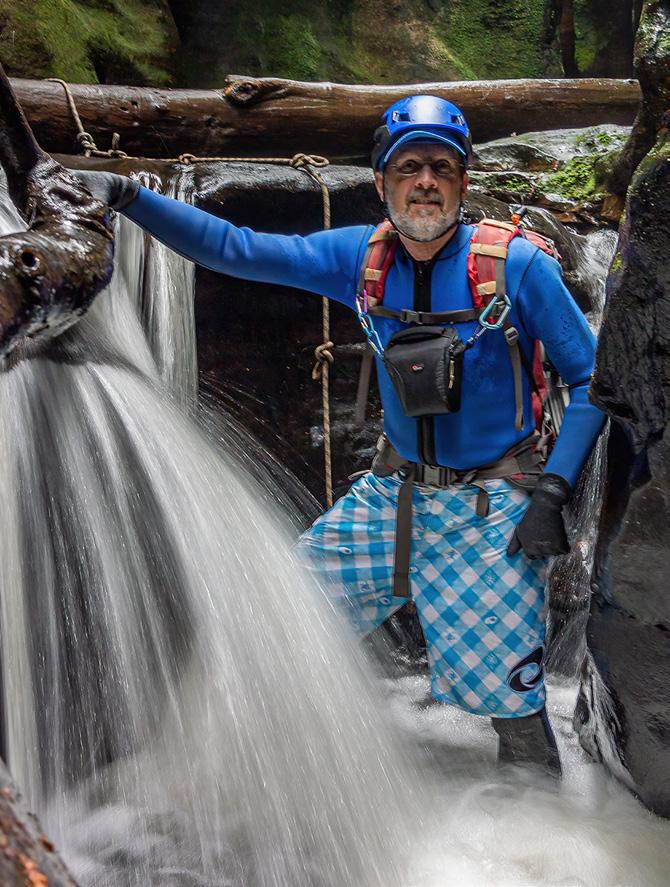
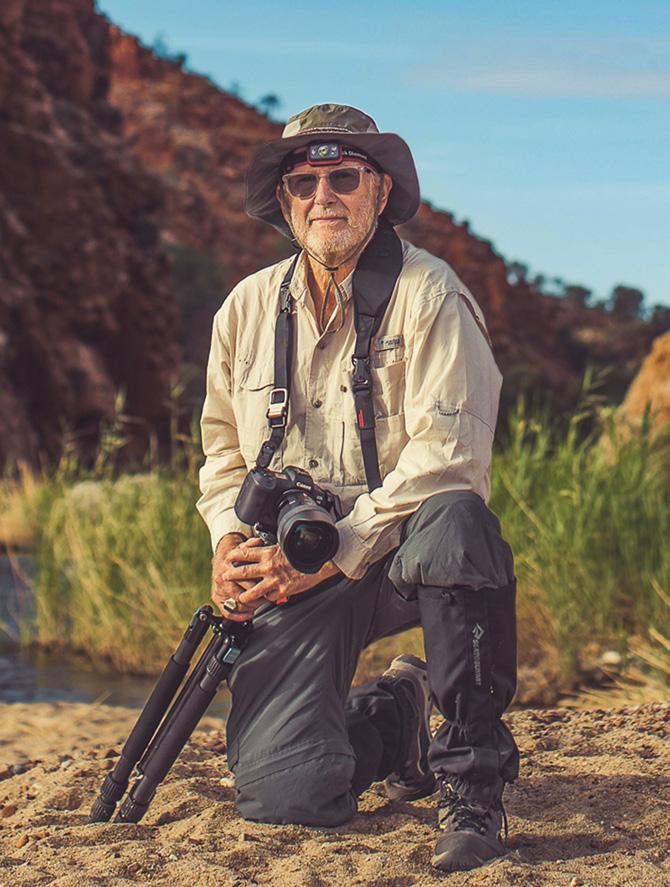
As nature would have her laughing way with us mere mortals, she arranges for the trek back to the
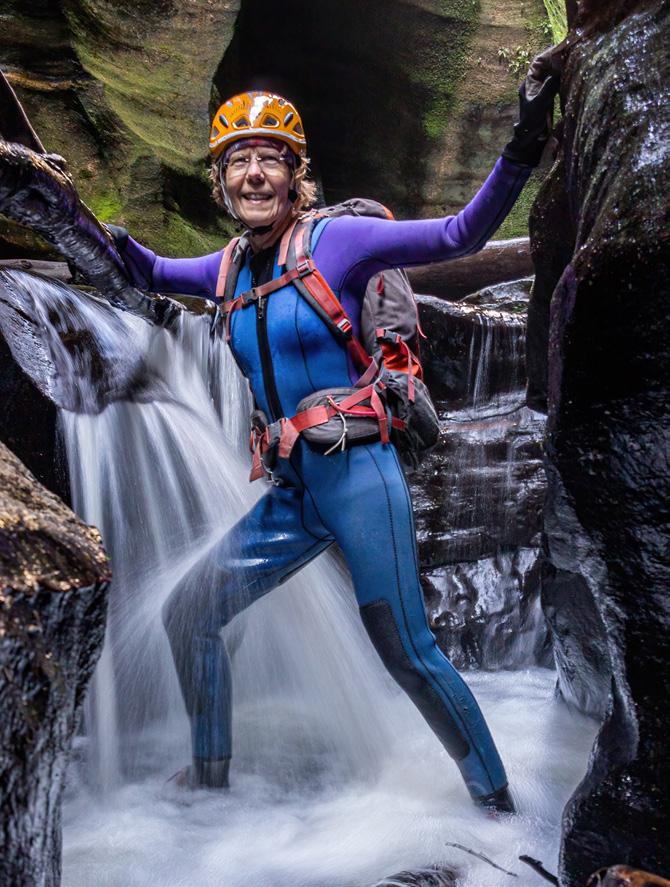
car to be ‘twice the fun’ as it’s all uphill the whole way with heavier packs as everything is wet. One advantage of a wet pack, is that the water dripping off, cools you as you walk. An exact reverse of our inward journey. I found the toughest part to be the very steep, eroded track close to the beginning of the walk. A ten-minute break had me back on my feet and onward and upward into the newly discovered luxury of a car seat. It’s never felt so good. This adventure was a present from Albert and Eliane as a thank you for things I had been able to do for them. It was a great and totally memorable adventure. Thank you, friends
See more of Brian and Albert’s work
instagram.com/brianmenzi/ facebook.com/albert.hakvoort.96
In the summer of 2019 I was diagnosed with Autism Spectrum Disorder (ASD), something which provided me with a clearer insight into why I see, hear and feel the world differently to many people around me.


A few years prior to this I began delving into the world of photography, a hobby which soon took me on a whirlwind journey
of photographic exploration and experimentation. As a result of my autism diagnosis and, as my photography evolved, I have realised that it is totally fine to be different and that autism is something to celebrate. Photography has played a significant role in helping me understand and accept my autism, whilst autism, on the other hand, has helped me define my creative
Autism has often been perceived as abnormal but, regardless of where autistic people sit on the spectrum and the challenges they face, the way in which they see, hear and feel the world is ‘their normal’. So for me, autism isn’t an abnormality but instead a collection of idiosyncrasies which defines who we are as individuals.
I haven’t always seen things this way and in the past I struggled to work out why my behaviour was different to other people and, more importantly, how I could fit in. Indeed, at the time I falsely believed that my idiosyncrasies were something to be ashamed of and something to hide. In an attempt not to stand out, I began to imitate their behaviour in order to give the appearance of being like them. I have since referred to this disguise as the Cloak of Conformity and the Corset of Expectation. The Corset of Expectation shaped me into an idealised form whilst the cloak displayed a version of me to the world which said ‘I fit in’. However, continually trying to emulate ‘normality’ was very exhausting and caused much anxiety.
Although, when I took up photography I didn’t know that I was autistic, I was aware that something wasn’t right. I was also suffering from an increased level of anxiety. However, as I became totally absorbed by my new hobby, I realised that photography was enabling me to switch off from the rest of the world.
One photography project led to another and another and before I knew it I had obtained both my LRPS and my ARPS. Whilst I was thinking about putting a fellowship panel together, I was also going through my autism diagnosis so

it made perfect sense to me to portray a version of my newly identified autistic reality through my images. It was my aim to provide a snapshot of how I see the world and to emphasise that my autism is an integral part of who I am.
Encouraged by the positive response that my FRPS panel had received, I then started to think about this idea of the Cloak of Conformity and the Corset of

Expectation. Was there a way in which I could raise awareness of the fact that autism isn’t a barrier to creativity and highlight the ways in which photography can have a positive influence on autism? Maybe I could spread the word amongst fellow photographers in the form of a presentation. So, at the beginning of 2022, I approached the RPS who were very happy to add my talk to their existing programme. Thanks to the response of the audience, ‘The Cloak of Conformity and the Corset of Expectation’ is now a talk which I regularly present to camera clubs, charities as well as to a variety of other groups.
“Far from being a hindrance Alison had used her autism to great advantage in her photography to demonstrate her really exciting individuality - something we should all wish for.”
Fuelled by the response to my talk I was keen to see if there were any ways in which I could use my photography knowledge in order to help autistic people directly.
In 2021 an opportunity presented itself as a result of becoming a member of a new RPS working group known as Critical Friends, a group which a year later became the Equality, Diversity and Inclusion Committee.
Following a discussion with members of the group, I suggested that I would like to do something to help autistic adults access the benefits of photography. Passionate about improving mental health, and keen to promote inclusion within education, the idea of setting up a photography workshop seemed the obvious direction to go in.
Since then, with the support of the RPS, I have been running free, five week virtual workshops for small groups of autistic adults. The aim of the workshop is to provide a comfortable environment in which participants are encouraged to
explore their individual creative expression through photography.
Accessibility is a key element to the workshop. I chose a ‘virtual’ format, not only to provide the opportunity for geographic inclusion, but also because it allows participants to choose how they interact with the group. I also make it very clear that participants don’t need any previous photography experience nor do they need any expensive equipment. In fact the majority of participants use a mobile phone. Each week we look at one of four themes, Shadows, Reflections, Patterns or Textures and participants are asked to make photos between sessions. I chose these particular themes because I felt they would provide participants with ample opportunities to make photos either indoors or outside and at any time of the day, thus
maintaining the fundamental idea of inclusion. Participants are encouraged to experiment and take advantage of the way they see the world in order to create their own individual interpretations of the themes.
“This workshop has helped me develop my photography by looking at/seeing subject matter in a different light.”
At the beginning of each session we spend time looking at the images and everyone has the opportunity to comment on each others’ photos, and to explain what they like about their own work. This exchange of ideas is an important part of the workshop and has proved very popular with participants who value their shared sense of curiosity with their surroundings and their common desire to capture moments in time.

In addition to creating images, the group also explores the ways in which photography can have a positive impact on autism. One example is to look at how photography projects can help by providing structure, focus and headspace. Firstly, hyper-focus is one of the common denominators amongst those on the spectrum, and having projects to work on fuels a need for autistic people to channel their concentration on a particular subject. Secondly, many people on the autism spectrum need structure in their everyday lives, and projects help by providing part of the framework. Lastly, but possibly most importantly, projects can give autistic people the valuable headspace they require in order to escape from some of the overwhelming pressures caused by their autism. It is almost like carrying out a factory reset on a brain which has become overloaded and no longer knows how to cope
with what is being asked of it. This access to headspace helps to alleviate anxiety.
“The practical exercises had a positive impact on my mental wellbeing by providing me with headspace and giving me projects to focus on.”
Understanding my relationship with autism and photography has encouraged me to help raise awareness of autism within the photographic community and to play a part in enabling autistic people to explore their own interpretation of the world through photography.
Photography, like other forms of creative expression, can help to further the recognition and acceptance of individuality. Instead of trying to mould ourselves into an ill-fitting disguise we should celebrate the richness and value of diversity

If you are interested in finding out more about the Photography and Autism workshop or The Cloak of Conformity and the Corset of Expectation talk, then please contact Alison via her website at alisonwebberphotography. com or directly at alison@ alisonwebberphotography.com
RPS
groups have joined forces to deliver a new programme for members. The first one starts in the autumn when we focus on Coastal photography


By working together in this way we can combine our strengths and widen our audience. We share a fair proportion of members and those individuals will know that both offer great opportunities for members to engage in a variety of programmes. So we are a good fit for working together.
The T-W-T project has three elements:
Talk - an online Zoom talk on 7 September, by the recent past LS group Chair, Richard Ellis. Richard will deliver a presentation that will guide and advise those less familiar with the genre as to how to achieve the best results.
Walk - we will have a series of walks around the UK mainland and UK islands throughout late September to end of October. These will be led
by local people who know their area well. They are not experts in the subject but there to simply lead a small number of photographers on the walk.
Talk - the final session is the feedback where you will meet locally at an agreed time and place for your walk group to mutually discuss and enjoy viewing each other’s images.
We appreciate that joining faceto-face meetings is not easy for
some of our members living on remote islands so we are offering an adaptation of the programme exclusively for them, which will culminate in a Zoom discussion meeting. We absolutely understand that there are other groups within the UK, and international members for whom attending face-to-face meetings is difficult, so in the future we hope to be able to offer options to suit them also.
The Talk and Walk are FREE for members. The final Talk (feedback)
session is down to local groups to organise themselves and share the cost accordingly.
A special web page displaying a map of the UK will show all the various walk locations. You click on the one that you wish to join and complete the booking there. This also includes the booking for the 7 September online tutorial. If you wish to go to more than one walk then this is perfectly fine. Bookings will open in July
rps.org/di/talk-walk-talk-coastal
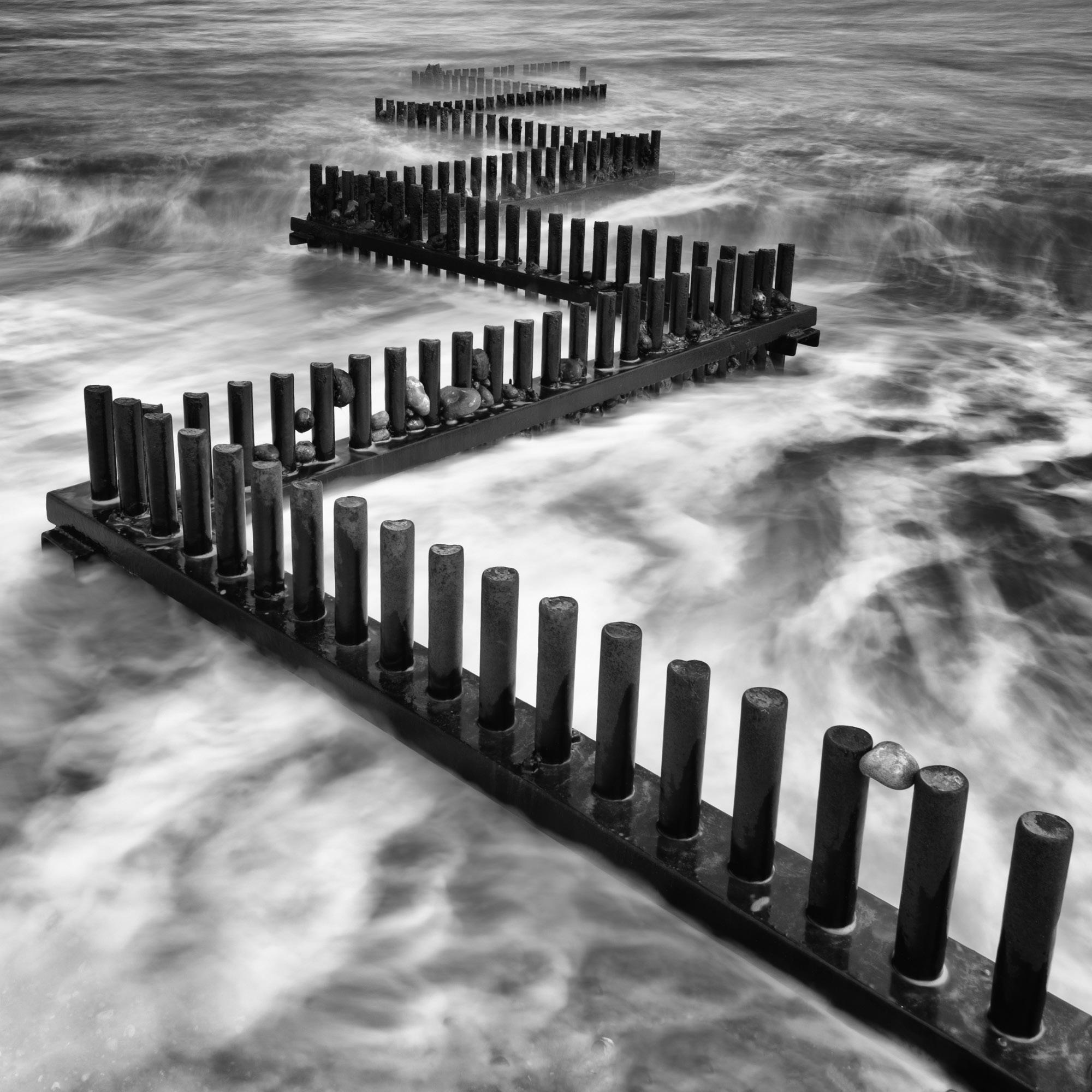
I have been experimenting with intentional camera movement (ICM) photography, and more recently, in camera multiple exposure (ME), over the last 18 months. I enjoy the freedom of expression and creativity that the technique gives me. To make an image that perhaps portrays my emotional response to a scene and a sense of the place, rather than a record of what I saw.

The inspiration for this particular image came from the contrast of colour between the fresh, green, and new spring foliage of the young trees, against the older, rusty orange leaves of the bushes below.
I captured a couple of ‘straight’ images at first to see if the colour contrasts may work as a ME and then I started to experiment.
My camera (a Canon R5) enables me to capture up to nine exposures at a time, although I have been tending to opt for just two or three. Although it is possible to use post processing techniques to blend individual photographs, I prefer to be making my images outside in the field, rather than later at the computer screen, and the Canon provides a choice of four blend modes. For this image I selected a two-shot ME and the Dark Blend mode.
The next decision for me was exposure time. This will depend on subject, available light and intended camera movement, but I tend to start with a setting between 0.5 and 1.5 seconds. The available light will affect whether I can achieve my desired exposure time, by only adjusting the aperture and ISO, or whether I need to attach ND filters. In this case the use of a polariser and a small aperture, with an ISO of 100, was enough.
I started at f/22 and a 1.3 second exposure time and began to move. First horizontally and then vertically. I
use Image Review regularly to see if my experiments are producing something that appeals. I must confess that I am still very much at the experimental stage of my image making and therefore don’t usually have set ideas about what I am trying to achieve. If my initial experiments look promising I will continue. Otherwise, I will move on. In this instance I could see early on that I was liking what I was doing and I decided to reduce my exposure time to 0.5 seconds (f/16) and slow my movements down so that I was retaining more of the form of the subjects.
I always choose to keep all the individual RAW files until I have seen the images on the computer. This gives me the option to take the multiple exposures into Photoshop, to use the various blend modes available, to experiment more. However, for this image I really liked the in-camera blended image and it took only minimal processing, in the Basic panel of Lightroom, to create a final image that I very much enjoy for its painterly style l

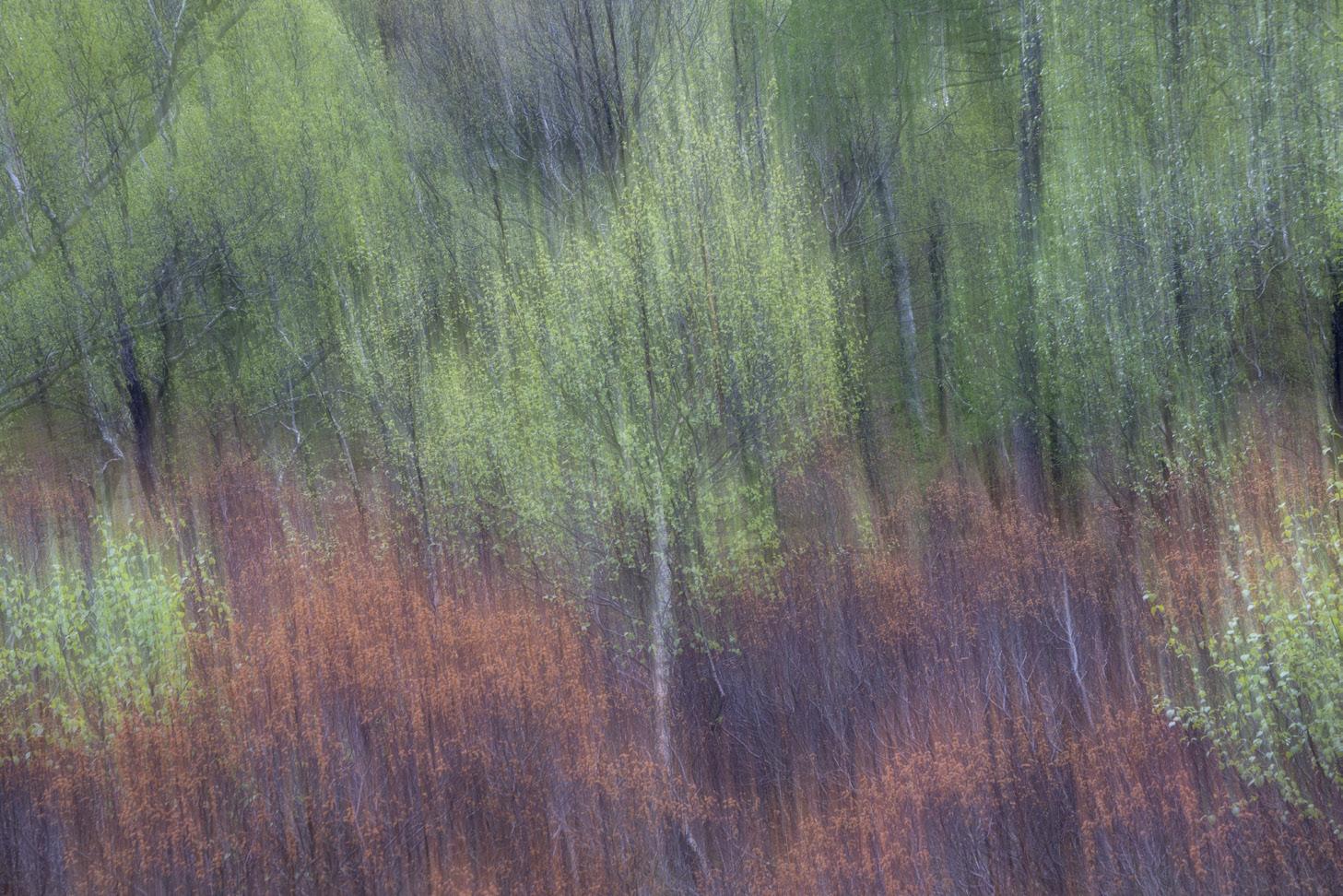

KEN HURST-EARL
The image The Shipwreck came about because of a challenge that is run over ten months by the Beacon Camera Club in Malvern, of which I am a member.
Every month a new theme is set at the beginning of the season for anyone wishing to participate and Surreal was the theme I was looking forward to.
I like compositing so this theme was a good one for me but it proved a lot more difficult than I thought. (This is due to a lack of skill on my part, not how difficult the image was).
Two problems immediately presented themselves. Firstly, the image - not the finished item, but a loose idea which (hopefully) would evolve as the image took shape. Secondly, once I had figured it out, how to do it.
I ended up with 13 different images, all of which were selected from a lot of different folders after discarding many more that didn’t work.
What follows is the shortened version of how the final image was put together. There were so many steps that to list them all would send the reader to sleep, so here goes.
The first step was to choose the background which was made of three cropped images. These were a beach image for below the surface of the water, the water itself, and the sky.
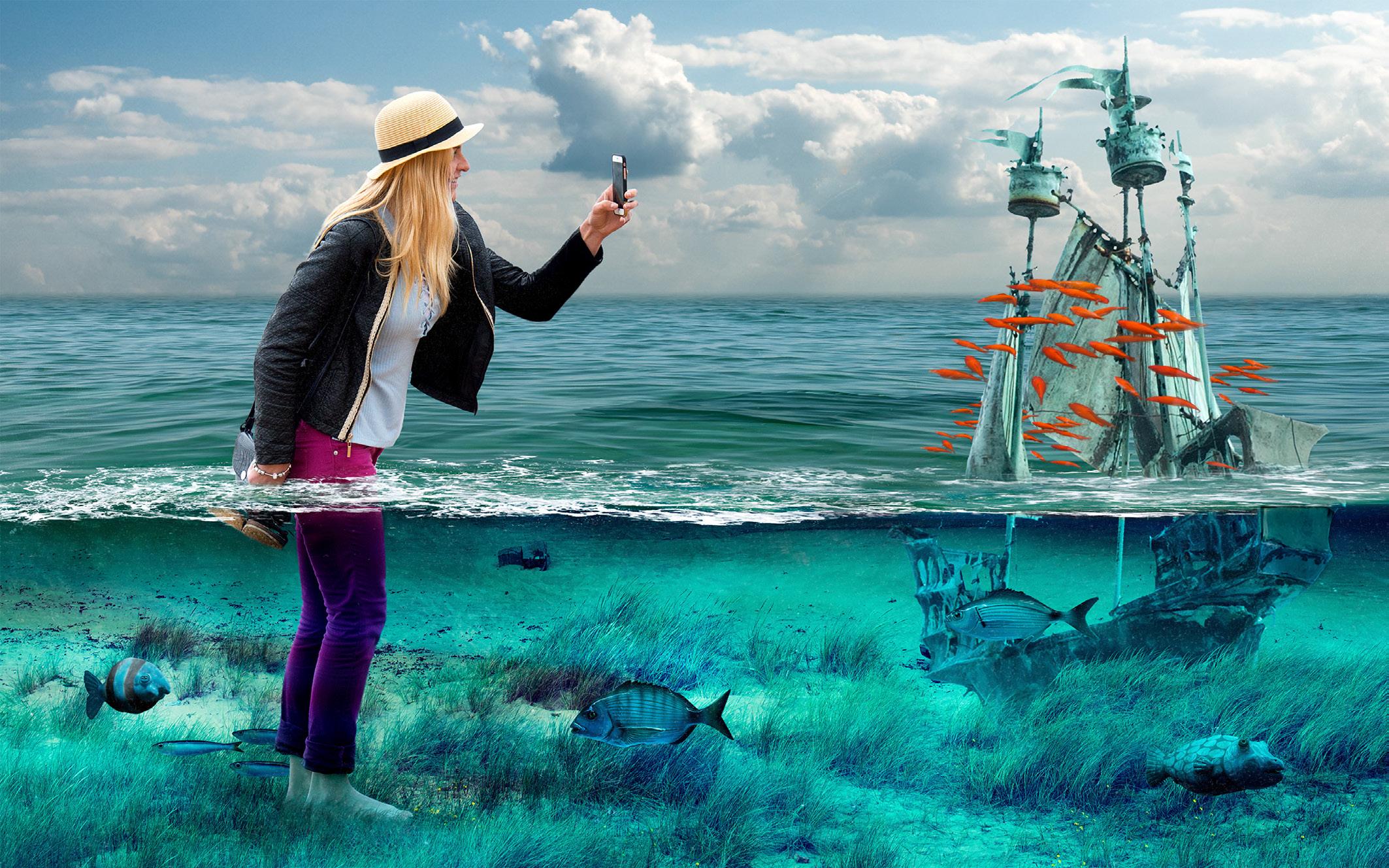
The water was laid over the beach and the sky, slightly below the horizon of the water and blended with a layer mask using a gradient tool.
Over the beach layer, two solid colour layers blended together and a third green textured layer were placed to give the illusion of water below the surface.
Next, the girl was placed in the water over the top of the preceding layers and from the waist down, the legs and feet were then cut out and placed underneath the solid colours and texture layers. The part of the girl where her
body entered the water was gently and partly rubbed out using a layer mask. Some adjustment had to then be carried out to remove the textured layer from the legs. Time for the ship. This image was sitting on top of a globe in Portmerion.
I cut out the globe out and placed the ship into the image cutting out the area where the dune grass would cover the bottom of the ship.


Once the ship was in the water, I placed some sea foam into the picture to hide the joins and make it look a little more realistic.
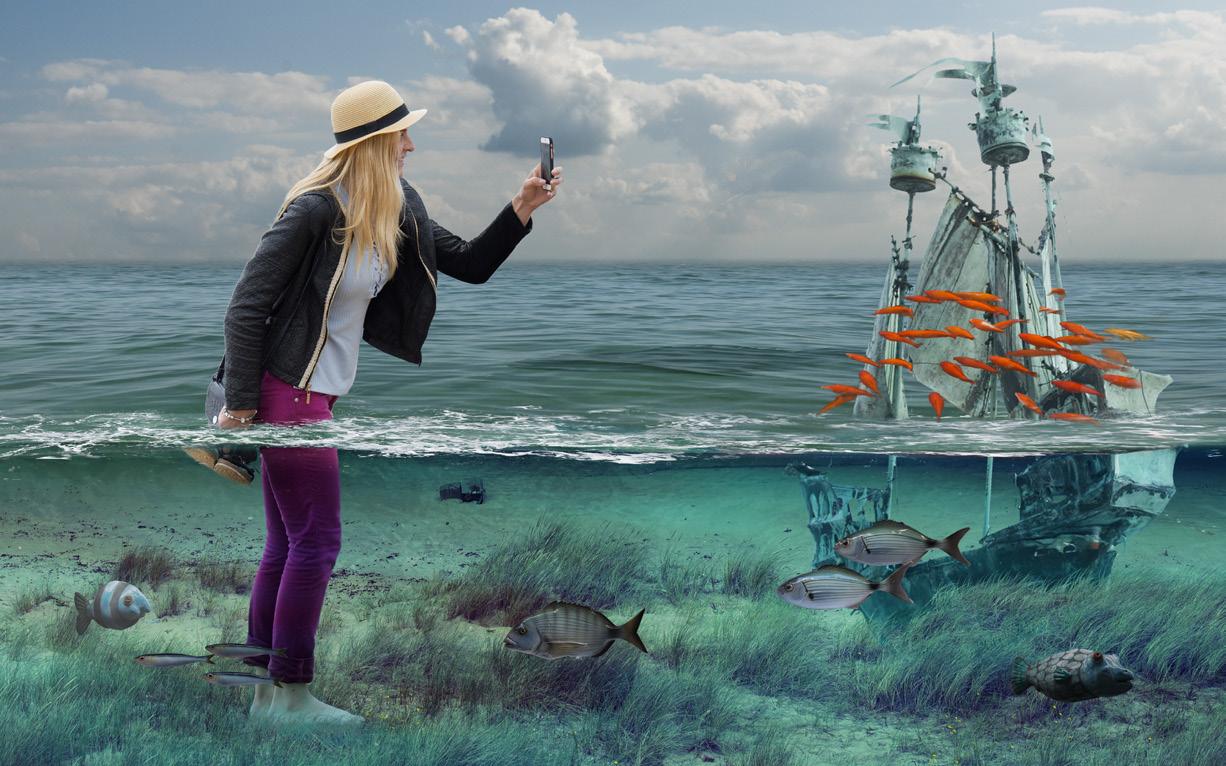

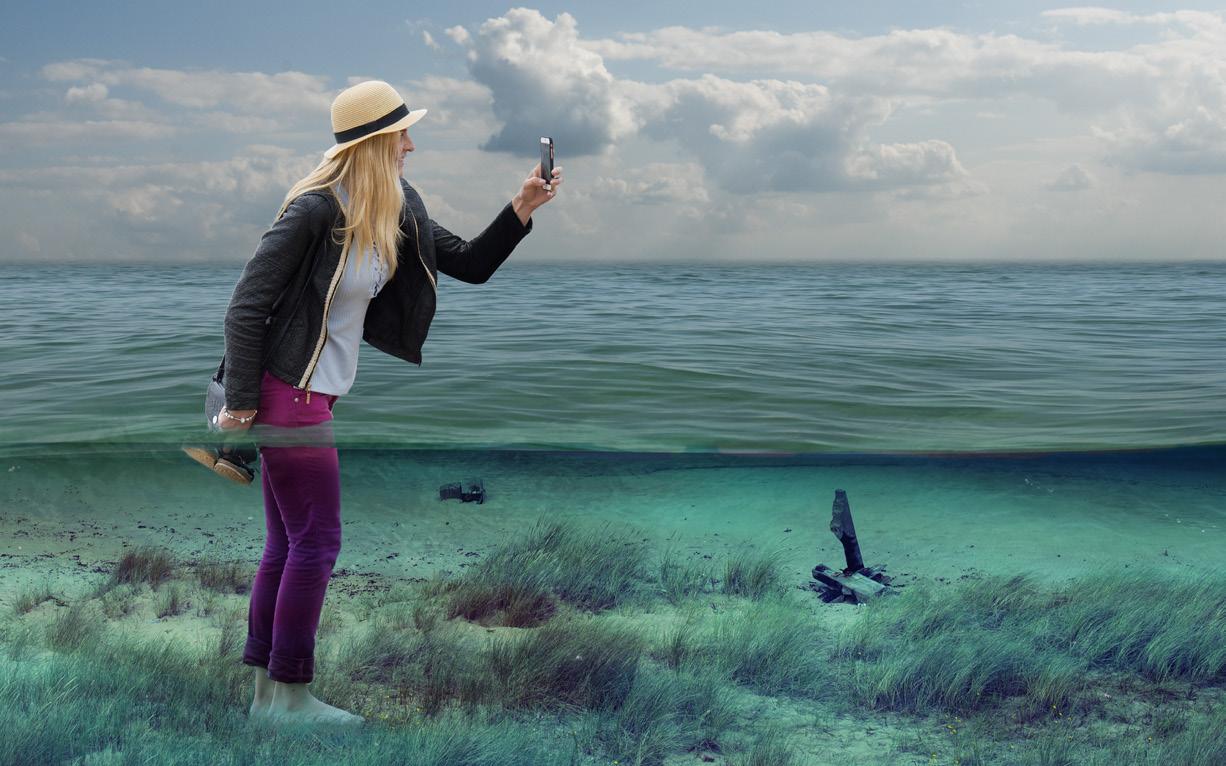


If wishes were fishes! Luckily, I had some fishy images that I’d taken in Ortega. Wherever I go, I like to take snaps of stuff that I might use later.
There are eight different fish images in this picture and so I carefully dropped them in but after looking at the image the next day, I decided to place the goldfish in the air around the sails of the ship. Much better and a lot more surreal.

Lastly, I tweaked the colours and filters, adjusted the whole thing and gave it some contrast


All previous issues are available from the DIGIT Archive at rps.org/di/digit-archive/.
